
i
QGN 16
Guidance Note for Fatigue Risk
Management
Coal Mining Safety and Health Act 1999
Mining and Quarrying Safety and Health Act 1999

[Type here]
© State of Queensland, Department of Natural Resources and Mines, 2013.
The Queensland Government supports and encourages the dissemination and exchange of its information. The
copyright in this publication is licensed under a Creative Commons Attribution 3.0 Australia (CC BY) licence.
Under this licence you are free, without having to seek permission from Department of Natural Resources and
Mines, to use this publication in accordance with the licence terms.
You must keep intact the copyright notice and attribute the State of Queensland, Department of Natural
Resources and Mines as the source of the publication.
For more information on this licence visit http://creativecommons.org/licenses/by/3.0/au/deed.en

[Type here]
Foreword from the Commissioner for Mine Safety and Health
Fatigue has long been recognised as a hazard in the mining industry. There has been a
considerable body of research and development work done in this area in recent years. The
mining industry in Queensland is aware of the hazards associated with fatigue and is
proactively seeking solutions and control strategies.
This document, “Guidance Note for Fatigue Risk Management”, outlines the various
considerations to effectively manage fatigue. It provides mine operators (coal mine
operators, mine and quarry operators) and mine workers (coal mine workers, mine and
quarry workers) with a comprehensive overview of the factors that contribute to workplace
fatigue and how they can be controlled. Fatigue is no longer viewed as an issue only for the
individual; rather it is a multi-facetted hazard that requires a multi-facetted approach to
manage the risk.
This guidance note supersedes the 2001 Guidance Note for Management of Safety and
Health Risks associated with Hours of Work Arrangements at Mining Operations produced
by the then Department of Natural Resources and Mines.
The knowledge and application of evidence based fatigue risk management practices has
increased dramatically since 2001, and this guide incorporates information, research and
good practice from a number of sources. It provides a human factors approach
acknowledging the inter-relationship between people, workplace and management factors
influencing fatigue in the workplace.
This guide addresses the fatigue-related factors in all elements of the system. The goal is to
reduce the likelihood of fatigue-related incidents or errors.
This document was prepared to assist mine and quarry operators and workers in taking the
necessary measures to control the risks associated with fatigue.
Stewart Bell
Commissioner for Mine Safety and Health
The interaction of
human factors
[Type here]
Acknowledgements
This guide is based on the Industry and Investment New South Wales (NSW) document,
Fatigue management plan: a practical guide to developing and implementing a fatigue
management plan for the NSW mining and extractives industry, which has been developed
and endorsed by the NSW Mine Safety Advisory Council. The NSW publication also used
content from the joint WorkSafe Victoria and WorkCover New South Wales guidance
(Fatigue - prevention in the workplace). The Department of Natural Resources and Mines
(DNRM) acknowledge the assistance of Industry and Investment NSW in allowing the use of
the document in developing this guide.
In the development of this guide a number of other fatigue guidance publications were
consulted as well as research on sleep, fatigue, sleep disorders and other related issues.
This guide received input from and review by the Queensland Mine Safety and Health
Advisory Committee (QMSHAC) and Queensland Coal Mine Safety and Health Advisory
Committee via the joint Fatigue Working Party. Organisations represented on the QMSHAC
Fatigue Working Party are: the Australian Workers Union; Construction, Forestry, Mining and
Energy Union (Mining and Energy Division); Queensland Mine Safety Advisory Committees;
DNRM Safety and Health and Queensland Resources Council (QRC).

[Type here]
Guidance Note – QGN 16
Guide to Fatigue Risk Management
This Guidance Note has been issued by the Mines Inspectorate of the Department of Natural
Resources and Mines (DNRM). It is not a Guideline as defined in the Mining and Quarrying
Safety and Health Act 1999 (MQSH Act) or a Recognised Standard as defined in the Coal
Mining Safety and Health Act 1999 (CMSH Act). In some circumstances, compliance with
this Guidance Note may not be sufficient to ensure compliance with the requirements in the
legislation. Guidance notes may be updated from time to time. To ensure you have the latest
version, check the DNRM website: https://www.business.qld.gov.au/industry/mining/safety-
health or contact your local Inspector of Mines.
North Region
PO Box 1752
Townsville Qld 4810
Ph (07) 4447 9248
Fax (07) 4447 9280
North Region
PO Box 334
Mount Isa Qld 4825
Ph (07) 4747 2158
Fax (07) 4743 7165
North Region
PO Box 210
Atherton Qld 4883
Ph (07) 4095 7023
Fax (07) 4095 7044
South Region
PO Box 1475
Coorparoo Qld 4151
Ph (07) 3330 4272
Fax (07) 3405 5345
Central Region
PO Box 3679, Redhill
Rockhampton Qld 4701
Ph (07) 4936 0198
Fax (07) 4936 4805
Central Region
PO Box 1801
Mackay Qld 4740
Ph (07) 4999 8511
Fax (07) 4999 8519
[Type here]
Contents
Acknowledgements i
Contents iii
Purpose of this document 1
Glossary 2
Preface 5
Obligations under Queensland legislative and regulatory requirements 5
Obligations for persons 5
Obligations of holders, operators and SSEs 5
Obligations to ensure an acceptable level of risk is achieved 6
Obligations for consultation with workers 7
Obligations for planning, organisation, leadership and control 7
Summary 8
What is fatigue and why is it a problem? (Chapter 1) 8
Who needs a fatigue risk management plan? (Chapter 2) 8
Developing and implementing a plan to manage the risk of fatigue (Chapter 2) 8
Consultation (Chapter 3) 8
Role clarity (Chapter 4) 8
Risk management (Chapter 5) 9
Documentation (Chapter 6) 9
Implementation (Chapter 7) 9
Evaluation (Chapter 8) 9
1. Introduction 10
1.1 Background 10
2. Fatigue risk management plan: development and implementation overview 12
2.1 Introduction 12
2.2 Approach 12
2.3 Resources needed for an effective fatigue risk management plan 14
3. Consultation 15
3.1 Introduction 15
4. Roles and responsibilities 16
4.1 Operator/SSE 16
4.2 Mine workers (or coal mine workers) 16
4.3 Who should be involved in implementation of fatigue prevention and management 16
4.4 Approach 17
5. Fatigue risk management 19
5.1 Introduction 19
5.2 Hazard identification: identifying factors that may contribute to fatigue 20
5.3 Risk assessment 22
5.4 Risk control 31
[Type here]
Process for using the risk factor and control tables (Tables 1-4) 33
5.5 Evaluation 45
6. Fatigue risk management plan documentation 46
7. Fatigue risk management plan implementation 47
7.1 Introduction 47
7.2 Timeframes 47
7.3 Training 47
7.4 Communication 48
7.5 Responsibilities 48
7.6 Supervision 48
7.7 Reporting 48
8. Fatigue risk management plan: monitoring and evaluation 49
Appendix 1: Suggested components of worker (and supervisor) fatigue risk management
training 50
Appendix 2: Tips for individuals on avoiding fatigue 51
Appendix 3: Accessing further resources and references 52
Appendix 4: Principles for risk management scoping and review to assist with
planning the fatigue risk assessment 55
Appendix 5: Key points for journey management or commute management plan 57
List of tables
Table 1 Direct risk factors 36
Table 2 Contributing risk factors 40
Table 3 Contributing risk factors: Work design and task specific factors 42
Table 4 Contributing risk factors: Individual and site specific factors 44
List of figures
Figure 1 Fatigue risk management plan: development and implementation overview 13
1
Purpose of this document
Guidance on
how to
systematically
manage fatigue
risks
The purpose of this guide is to provide guidance to mining (and coal
mining) operations on how to systematically manage fatigue risks in the
workplace so that the obligation holders comply with the legislative
framework. The guide will help sites develop and implement a fatigue
risk management plan which will contain strategies to effectively control
the risks of fatigue. It sets out a risk management approach based on
consultation with the workforce. The approach requires that mine
(including coal mine) sites:
identify the hazards of fatigue
assess the risks of fatigue using available scientific evidence and
current practice*
implement effective risk control measures
monitor and review regularly the effectiveness of the controls.
Plans must
cover fatigue
risk factors, and
fatigue
contributors as
well as site-
specific needs
The guide is not prescriptive, which means that individual operators and
sites can develop a plan that is specific to their needs. However, all
plans should address each of the main areas identified in this document.
Some smaller sites and quarries may determine that they do not have
the fatigue risk factors that apply to many operations that operate 24
hours. They may find that their planning for fatigue will include a risk
assessment indicating that they have a low risk of fatigue, rather than
developing a plan. The management of fatigue should also be
incorporated in the overall safety and health management system.
* Specific requirements for risk assessment for personal fatigue apply under the Coal Mining
Safety and Health Regulation 2001(CMSH Regulation), s.42 and s.10

2
Glossary
Term
Description
Active work
Total time spent at work including overtime. This does not include
time travelling to or from the work site or rest breaks during shifts.
BIBO
BIBO (bus in/bus out) can be used to describe sites where
workers are bussed to and from site on a daily basis. This does
not necessarily mean that a residential camp is provided – it may
be to and from a township.
Commute
Commute is the term given to the journey for a worker to and
from their permanent home, or in some cases, the site
accommodation to the site. It may involve air travel, driving,
company provided bus, car pooling or other means of transport.
The commute can involve both a daily commute to the mine site
(or coal mine site) and, in some cases, a commute to the
worker’s permanent home at the beginning and end of a work
cycle or roster.
Commute management
plan or journey
management plan
The commute (or journey) to and from the mine site can involve
significant distances of driving, bussing (or flying) for some
workers. This can add a number of hours to the period that
workers will be awake (see wakefulness). It is important for sites
to consider factors such as number of hours driving to and from
site on a daily basis, distances travelled, and/or likely number of
hours driving before and after rosters. Sites should also have a
change management process in place for workers to notify the
site designate for changes to their journey plan. This information
forms the commute management or journey management plan
for workers.
Consultation
Consultation with workers is discussion between the site senior
executive or supervisors and affected workers about a matter
with the aim of reaching agreement about the matter. Further
requirements for consultation are specified in legislation and in
this guide.
DIDO
DIDO (drive in/drive out) is the term for sites where workers travel
to site by road, without air travel being provided for access to the
site for all workers. There will still be some workers who fly in to
the nearest airport and drive to (or are driven to) site.
Extended working
hours
Generally, working beyond eight hours is considered to be
extended working hours in other industries and guidance. In
mining, working hours in excess of established rostered hours,
including overtime would be considered extended working hours.
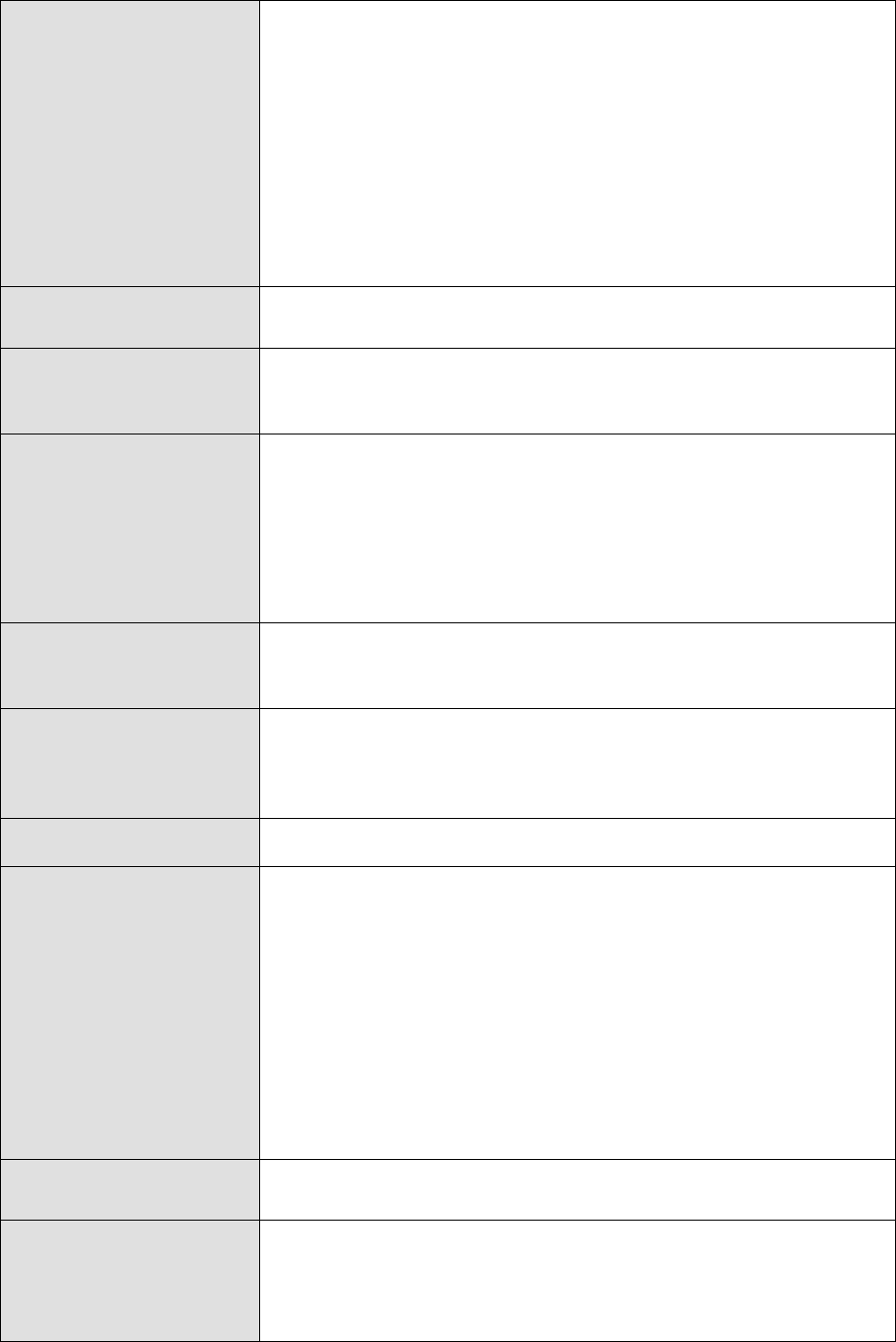
3
Fatigue
Fatigue can be defined as a state of impairment that can include
physical and/or mental elements, associated with lower alertness
and reduced performance. There are a number of contributing
factors to fatigue, but they usually relate to lack of sleep quantity
or quality, extending the time someone is awake (see
wakefulness and extended wakefulness), or other work related or
individual factors.
Fatigue due to loss of sleep quality or quantity can be
experienced after a short period of exposure to sleep loss (acute
fatigue) or over a longer period of time where sleep loss has
accumulated (cumulative fatigue).
FIFO
FIFO (fly in/fly out) is the term given to mining operations that
have accommodation provided, and have workers flown in.
FFW
Fitness for work as used in the Coal Mining Safety and Health
Regulation 2001 (CMSH Regulation), and Mining and Quarrying
Safety and Health Regulation 2001(MQSH Regulation).
Hazard
Hazard (as defined in the CMSH Act, s.19 and MQSH Act, s.20)
means a thing or a situation with potential to cause injury or
illness to a person.
Note: The above definition is not an exclusive description, and
sites can include alternate definitions, for example “hazard
means a thing or a situation with potential to cause harm,
damage, injury or illness to a person.”
Operator/site
Any person or organisation responsible for the employment of
one or more workers on-site. Site includes both coal mine site
and mine site under Queensland mining legislation.
Risk
Risk (as defined in the CMSH Act, s.18 and MQSH Act, s.19)
means the risk of injury or illness to a person arising out of a
hazard. Risk is measured in terms of consequences and
likelihood.
Rostered hours
The hours a worker is rostered to work.
Safety critical task for
fatigue-related issues
or incidents
Although fatigue will have a potential effect on every worker on-
site, the consequences of fatigue will vary depending on the task
being performed. In Queensland mining, the following is the
preferred definition of safety critical tasks for fatigue or ill health.
“Those tasks undertaken by workers whose
action or inaction due to ill health or fatigue, may
lead directly or indirectly to a serious incident
affecting the health and safety of a number of
other persons.”
Sites may also choose to review tasks and identify those workers
who are continuously performing safety critical tasks.
Shift
The hours between the start and finish of established rostered
hours.
Site Safety and Health
Representatives
(SSHR) for mines and
coal mines
A worker elected or selected (under the MQSH Act, Part 7) or a
coal mine worker elected (under the CMSH Act, Part 7) to
represent workers at a mine or coal mine.

4
1
Dawson and Reid (1997) Fatigue, alcohol and performance impairment. Nature, 388: 235.
Site Senior Executive
(SSE) coal and
metalliferous
As per s.25 of the CMSH Act, the site senior executive for a coal
mine is the most senior officer employed by the coal mine
operator for the coal mine who—
(a) is located at or near the coal mine; and
(b) has responsibility for the coal mine.
or
As per s.22 of the MQSH Act, the site senior executive for a mine
is the most senior officer employed by the operator for the mine
who—
(a) is located at or near the mine; and
(b) has responsibility for the mine.
Time not working
Time outside of working hours. Does not include time travelling to
or from the work site.
Wakefulness and
extended wakefulness
Wakefulness is the term for the period, in hours, of being awake
from the previous block of sleep. Extended wakefulness is the
extended period of being awake that can increase the body’s
desire to sleep, known as homeostatic sleep drive. There is some
variability between individuals in the amount of time awake that
begins to affect performance, but research
1
suggests that after
approximately 16-17 hours of being awake, depending on time of
day, performance starts to decline.
Work cycles / rosters
The working period scheduled between any significant break
away from work.
Work week
This is the number of actual working hours worked by workers or
contractors in any seven day period and is not an ‘averaged’
figure over a monthly roster.
Worker (including mine
worker and coal mine
worker)
Any person who works on the mine (or coal mine) site,
regardless of their employer. This includes contractors. In this
document the term ‘worker’ applies to mine workers and coal
mine unless specific to the legislative context.

5
Preface
Obligations under Queensland legislative and regulatory
requirements
Relevant laws
oblige fatigue to
be eliminated or
controlled
Obligations exist under the Coal Mining Safety and Health Act 1999
(CMSH Act), and the Mining and Quarrying Safety and Health Act 1999
(MQSH Act) to control fatigue risks to as low as reasonably achievable.
The obligations and legislation provided in this guidance note are not
exhaustive, and all obligation holders need to refer to the CMSH Act or
MQSH Act and the Coal Mining Safety and Health Regulation 2001
(CMSH Regulation) or Mining and Quarrying Safety and Health
Regulation 2001 (MQSH Regulation) for the most recent and relevant
legislation that may apply. Legislation can be found at:
http://www.legislation.qld.gov.au/Acts_SLs/Acts_SL.htm
Obligations for persons
Obligations
under
Queensland
mining and coal
mining
legislation for
fatigue risk
management
apply to the
following
holder
operator
site senior executive
appointees in the site management structure
contractor
an erector or installer of plant at a coal mine
a person who supplies a service at a coal mine
supervisor
mine worker (or coal mine worker)
service supplier
persons generally.
Obligations of holders, operators and SSEs
Operators,
SSEs must
apply
systematic risk
management to
achieve an
acceptable level
of risk
ensure the safety and health of mine workers (including coal mine
workers) and visitors to the workplace with regard to fatigue
have a health and safety management system or plan that achieves
effective management and control of fatigue
consult with mine workers (or coal mine workers) and those doing
the work on fatigue risks (see Obligations for consultation with
workers, on page seven for specific requirements)
identify, analyse and assess fatigue hazards and resultant risk
avoid or remove unacceptable risk and control retained fatigue risks
monitor levels of fatigue risk and the adverse consequences of
retained residual risk
investigate and analyse the causes of serious accidents and high
potential incidents with a view to preventing their recurrence
review the effectiveness of fatigue risk control measures
take appropriate corrective and preventive action
mitigate the potential adverse effects arising from residual risk.
Mining and coal
mining
legislation
obliges
All mining (and coal mining) operations are subject to the Queensland
mining (and coal mining) safety and health legislation. This legislation
requires all obligation holders, including mining operators and SSEs, to
comply with their obligations above to achieve an acceptable level of
6
operators and
SSEs to comply
with their
obligations and
the objects of
the legislation
risk. An object of the CMSH Act and the MQSH Act is to protect the
safety and health of persons at mines (or coal mines) and persons who
may be affected by mining (or coal mining) operations.
Legislation
obliges mine
workers and
persons
generally to
comply with the
Acts,
Regulations and
applicable
safety and
health
management
systems
All persons on mining operations (and coal mining operations) are
subject to the Queensland mining (and Queensland coal mining) safety
and health legislation.
Obligations to ensure an acceptable level of risk is achieved
Fatigue is
managed so an
acceptable level
of risk is
achieved
The CMSH Act, s.30 and QMSH Act, s.27 provides that the systems
must incorporate risk management elements (or procedures) and
practices appropriate for each coal mine (or mine) to—
(a) identify, analyse, and assess risk
(b) avoid or remove unacceptable risk
(c) monitor levels of risk and the adverse consequences of retained
residual risk
(d) investigate and analyse the causes of serious accidents and high
potential incidents with a view to preventing their recurrence
(e) review the effectiveness of risk control measures, and take
appropriate corrective and preventive action
(f) mitigate the potential adverse effects arising from residual risk.
7
Obligations for consultation with workers
Consultation
with workers
according to
specific
requirements of
the legislation
Consultation with coal mine workers regarding fatigue must be in
accordance CMSH Regulation, s.10 and s.42 developing standard
operating procedures that apply to fatigue. This includes, under CMSH
Regulation, s.42 (5), that the site senior executive must consult with a
cross-section of workers at the mine in developing the fitness provisions
and comply with CMSH Regulation, s.42 (6, 6A) and s.8. In developing
the standard operating procedure for fatigue, the requirements of CMSH
Regulation, s.10 apply. Consultation with coal mine workers is also
specified under the CMSH Act, s.64 for changes to the safety and health
management system.
Under the mining and quarrying legislation, consultation with mine
workers is in accordance with the MQSH Act, s.56 (changes to the
safety and health management system) and MQSH Regulation, s.5 for
risk management practices and procedures that apply to fatigue.
Obligations for planning, organisation, leadership and control
SSEs have
obligations for
planning,
organisation,
leadership and
control under
s.42 of the
CMSH Act and
s.39 of the
MQSH Act
Although there is no specific requirement to develop a fatigue risk
management plan, under the CMSH Act, s.42 (f) there is a requirement
for the SSE: to provide for—
(i) adequate planning, organisation, leadership and control of coal
mining operations.
Under the MQSH Act, s.39 (f) the SSE is to provide for—
(i) adequate planning, organisation, leadership and control of
operations.

8
Summary
What is fatigue and why is it a problem? (Chapter 1)
Fatigue is a
state of physical
and mental
impairment
Fatigue can be defined as a state of impairment that can include
physical and/or mental elements, associated with lower alertness,
reduced performance and impaired decision making. There is a direct
link between fatigue and increased risk of being involved in an incident
or accident.
Who needs a fatigue risk management plan? (Chapter 2)
All sites to
conduct a
fatigue risk
assessment to
decide if a
fatigue risk
management
plan is needed
All mines and quarries (under MQHS Act, s.27) and coal mines (under
CMSH Act, s.30) are required to identify whether a fatigue hazard is
present, and if present to assess the risk of fatigue. A fatigue risk
management plan is required if fatigue risk factors are identified during the
risk assessment and the fatigue risk factor tables indicate that these factors
have a medium or high potential.
An operation’s fatigue risk management plan should cover all affected
parties, those who work on planned rosters and unplanned work, such as
overtime call-outs and involvement in emergency response. Commuting
times should also be considered.
Developing and implementing a plan to manage the risk of fatigue
(Chapter 2)
Help to develop
a site-specific
fatigue risk
management
plan
This document is designed to help the mining industry develop a
comprehensive plan to manage fatigue that is specific to their work and
site conditions. It proposes a suggested structure and approach,
however each plan can be expected to be different because it must take
into account the specific hazards, risks and tasks at the mine, and
surrounding conditions. An implementation and management plan must
be developed through a consultative process with stakeholders as
required under legislation. The developed plan should be clearly
documented, be readily available for use and inspection by all relevant
persons, and be reviewed on a regular basis. It should also be
integrated into the overall site safety and health management system,
contractor management arrangements and the operation’s health and
safety management system.
Consultation (Chapter 3)
Involve those
most likely to be
affected by
fatigue
Development of the fatigue risk management plan requires consultation
with all relevant parties, as per the legislation.
Role clarity (Chapter 4)
Identify
everyone’s role
The roles and responsibilities of persons within the organisation who will
have responsibility for developing and implementing the plan should be
identified.
9
Risk management (Chapter 5)
Risk
management is
the key to an
effective fatigue
risk
management
plan
The key aspect of developing a fatigue risk management plan for a
specific workplace is to undertake a thorough risk assessment and
implement a risk management plan (or to exercise a sound and
comprehensive risk management approach considering the complex
multifactorial nature of fatigue). This involves hazard identification and
risk assessment, control of the risks and evaluation of the effectiveness
of the risk controls. Risk assessment is a dynamic process, and the work
environment and systems should be evaluated regularly. The non-work
environment must also be considered. To assist the risk management
process, tools and guidance are provided in checklists, tables 1-4, and
Appendix 3 of this document.
Documentation (Chapter 6)
The plan must
be documented
A fatigue risk management plan must be fully documented and
integrated as part of an overall safety and health management system.
The fatigue risk management system components must be able to be
audited and assessed.
Implementation (Chapter 7)
Risk controls
must be put into
action if the
plan is to be a
success
The fatigue risk management plan must be implemented. Without
adequate risk controls being put in place, the work that has gone into
preparing the fatigue risk management plan will not be useful. Key
issues to consider in implementing the plan include timeframes, training,
roles and responsibilities, resources, communication and participation,
and the effectiveness of controls.
Evaluation (Chapter 8)
The plan must
be reviewed to
make sure it is
working
All aspects of the fatigue risk management plan should be audited and
reviewed at regular intervals to ensure continuing suitability, adequacy
and effectiveness of the controls for managing the risk.
10
1. Introduction
1.1 Background
What is fatigue?
When fatigued,
physical or
mental activity
becomes more
difficult to
perform
Fatigue can be defined as a state of impairment that can include
physical and/or mental elements, associated with lower alertness,
reduced performance and impaired decision making. Signs of fatigue
include tiredness even after sleep, psychological disturbances, loss of
energy, irritability, moodiness and inability to concentrate. Fatigue can
lead to incidents because workers are not alert and are less able to
respond to changing circumstances, thereby putting themselves and
others at risk. Fatigue can also impair decision making, and therefore
cause errors of judgement. As well as these immediate problems,
fatigue can lead to long-term health problems.
What causes fatigue?
Fatigue
develops
directly when
there is
insufficient
sleep quality or
quantity
Fatigue is a complex, multifactor problem that can have many
contributions. There are a number of ‘direct’ causes of fatigue, due to
insufficient sleep quality or quantity. The quantity and quality of sleep
obtained prior to and after a work period can be influenced by:
activities outside of work, such as family commitments, a second job,
or recreational factors
noise or other disturbances during sleep times
individual factors, such as sleeping disorders, health issues, or other
illnesses.
Fatigue most
commonly
arises from
periods of
wakefulness
without
adequate rest
Fatigue is usually considered to have two presentations, acute fatigue
and cumulative fatigue. Acute fatigue is experienced after a one-off or
immediate episode of sleep loss. For example, because of an extended
period of wakefulness, sleep disturbances or inadequate sleep. Ongoing
sleep disruption or lack of restorative sleep can lead to sleep debt and
cumulative fatigue, increasing the risk of fatigue-related incidents or
errors. Fatigue due to the effects of lack of sleep quality or quantity may
be experienced as cognitive (or mental) fatigue, and have effects such
as:
reduced coordination and alertness
changes in emotional function
changes in mental performance or decision making
micro sleeps during tasks.
If sleep loss continues, work performance can deteriorate even further.
Fatigue can
result from work
related or non
work related
causes, or a
combination of
both
Fatigue can result from work related factors, from factors in a worker’s
life outside work or in combination. Fatigue has known effects on certain
tasks or tests, but it is not consistently measurable without specific and
verified testing. Work-related fatigue can and should be assessed and
managed at an organisational level. The contribution of non-work-
related factors varies considerably between individuals. Non-work-
related fatigue is best managed at an individual level.
11
Work-related
causes of
fatigue
In addition to the previous direct factors affecting sleep quality or
quantity, there are additional work related factors that will have an
influence on fatigue development. These inter-related causes of fatigue
can include:
the time of day that work takes place
the length of time spent at work and in work-related duties
the type and duration of a work task, and the environment in which it
is performed
work design (monotony, highly demanding workloads, mentally
challenging work)
organisational factors leading to stressful work environments, such
as bullying, harassment or other psychosocial factors
roster design (e.g. too many consecutive shifts without sufficient
restorative sleep)
unplanned work, overtime, emergencies, breakdowns and call-outs
certain features of the working environment (e.g. noise or
temperature extremes)
commuting times.
Non-work-
related causes
of fatigue
Non-work-related causes of fatigue can include:
sleep disruption due to issues at home
strenuous activities outside work, such as a second job or other
recreational activities impacting on the person’s rest patterns
sleep disorders, insomnia and other diseases
use of alcohol, prescription medication or illegal drugs
stress associated with financial difficulties, domestic responsibilities
etc.
Why is fatigue a problem?
Fatigue
increases the
risk of incidents
and long-term
health problems
Fatigue most commonly causes an increased risk of incidents due to
physical and mental tiredness and lack of alertness. When workers are
fatigued they are more likely to exercise poor judgment and have a
slower reaction time to signals and demands. Fatigued workers are less
able to respond effectively to changing circumstances, leading to an
increased risk due to potential human error. Fatigue is known to also
increase risks off-site, for instance, when the person is driving back to
their home or accommodation.
Cumulative or long term exposure to fatigue, associated with shiftwork,
has been linked to long-term health problems, such as:
digestive problems
heart disease
stress and other psychosocial issues.
The most important reason for fatigue risk management in a work place is to get people
home safely.
12
2. Fatigue risk management plan: development and
implementation overview
2.1 Introduction
A fatigue risk
assessment
must be carried
out
Every mine (or coal mine) must conduct a fatigue risk assessment.
Under the CMSH Regulation the risk assessment must comply with s.42
and s.10. Under the requirements of MQSH Regulation mine and quarries
should incorporate s.6 and s.7. Some sites such as quarries or sites that
operate with limited rosters may find after conducting an assessment, that
they are at an acceptable level of risk of fatigue once the risk assessment
is completed.
A fatigue risk management plan is required if fatigue risk factors (see
Tables 1-4) are identified during the risk assessment.
What a plan
should cover
An operation’s fatigue risk management plan should cover managers,
professional staff, contractors, those who work on planned rosters and
unplanned work such as overtime and call-outs, and involvement in
emergency response. As responding to emergencies can often be
dependent on a very small number of emergency personnel, the scope of
this document does not deal with developing a fatigue risk assessment
during emergency situations. Commuting times should also be
considered.
How to develop
and implement
a fatigue risk
management
plan
This section considers the approach that should be used to develop and
implement the fatigue risk management plan in the workplace and to
integrate it with the health management plan, contractor management
arrangements and with the overall operational health and safety
management system or plan.
2.2 Approach
Policy
commitment
and
consultation are
central
The development and implementation of an effective fatigue risk
management plan should begin with making a policy commitment to the
effective management of fatigue risks in the workplace and establishing
appropriate consultation. Consultation is central to the development and
implementation of an effective plan. The process of development and
implementation is described in detail in the various sections of this
guideline and is outlined in Figure 1.
Everyone’s
roles and
responsibilities
must be
identified
Having committed to the policy and established the consultation
process, it is important to identify the roles and responsibilities of
persons within the organisation who will have responsibility for
developing and implementing the plan. The risk management approach
of identification, assessment, control and evaluation must then be
developed and implemented. This will involve training before
development and as part of the implementation. The fatigue risk
management plan will then need to be documented and implemented.
The effectiveness of the various control measures should be monitored
and evaluated on an on-going basis and the results used to review the
plan on a regular basis. The aim of this process is to produce a fatigue
risk management plan, then to implement the plan and to integrate this
process with the overall operational safety and health management
system. This is illustrated in Figure 1.
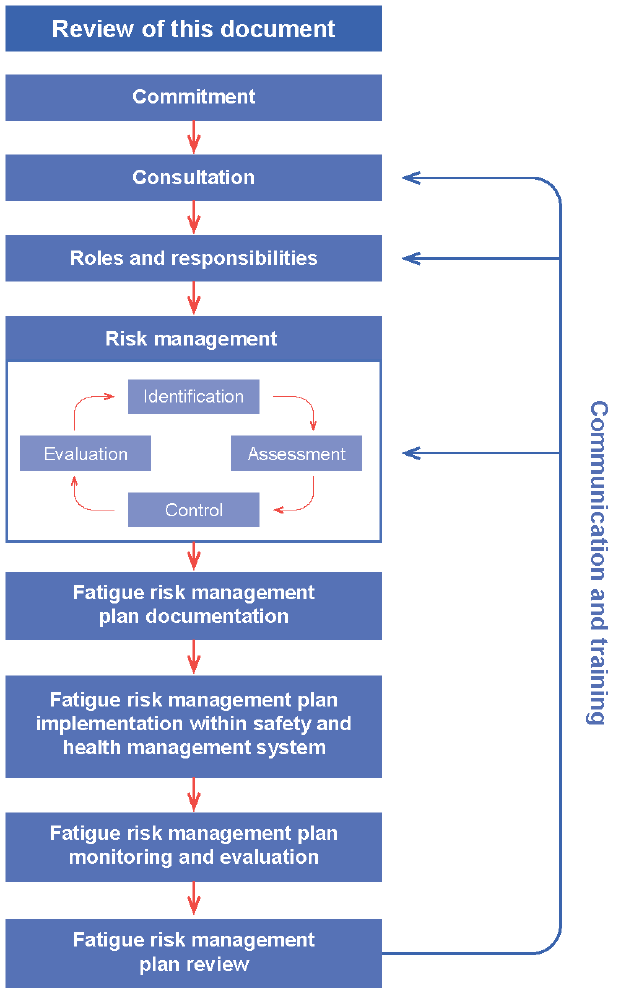
13
Figure 1 Fatigue risk management plan: development and implementation overview.
14
An effective
fatigue risk
management plan
details a
systematic
program
In summary, the development and implementation of an effective fatigue
risk management plan requires:
making a policy commitment to effective fatigue risk management
consultation with mine workers (or coal mine workers)
establishment of roles and responsibilities
risk identification, assessment, control and evaluation
training and review of training at relevant intervals in the process
documentation of the plan
implementation of the plan
development and implementation of assessment and monitoring
procedures
review and resultant modification of the plan if required.
2.3 Resources needed for an effective fatigue risk management plan
Appropriate
resources are
essential
Those responsible for the development and implementation of the
fatigue risk management plan must ensure that appropriate resources
are made available as per their legislative requirements under
Queensland legislation. In addition, as fatigue is a complex,
multifactorial problem, some sites may need to ensure that these
resources include those with the appropriate knowledge and
understanding of fatigue.
Further advice on accessing external resources is found in Appendix 3.
15
3. Consultation
3.1 Introduction
Consult with
workers most
likely to be at
risk
Consultation with those workers performing the work is important as they
are likely to have the best practical understanding of work processes and
the potential fatigue as a result of work-related or individual factors. Such
consultation is required under the mining and coal mining Acts as
discussed below. In addition, mine workers (or coal mine workers) are the
persons most likely to be at risk of developing the longer term health
effects associated with ongoing fatigue.
A process of
consultation
must
underpin the
fatigue risk
management
process and
plan
Key aspects of consultation relevant to the development of a fatigue risk
management plan include:
consultation by the operator/SSE with the workers to enable them to
contribute to decisions affecting their safety and health at work
regarding fatigue
information that must be shared includes matters that affect or may
affect the safety and health of workers
consultation with coal mine workers in accordance with the CMSH Act,
s.64 (changes to the safety and health management system) and
CMSH Act, s.10 and s.42 for developing standard operating
procedures that apply to fatigue
consultation with all other mine workers in accordance with the MQSH
Act, s.56 (changes to the safety and health management system) and
MQSH Regulation, s.5 for risk management practices and procedures
that apply to fatigue.
There are
different
ways to
consult
Consultation must be undertaken as required by legislation.

16
4. Roles and responsibilities
4.1 Operator/SSE
Operators and
SSEs have the
main
responsibility
for controlling
fatigue risks
Operators and SSEs hold the fundamental obligation for managing the
risks associated with fatigue. The fatigue risk management plan should
nominate those responsible for different actions. Some suggested
responsibilities for fatigue risk management is provided in Section 4.3. It
is the operator/SSE’s responsibility to make sure that fatigue is
managed using the risk management approach described in this
guidance note, or in another way that achieves the same result. The
fatigue risk management plan or policies should be signed off by the
most senior appropriate person representing the operator. Adequate
resources should be provided to allow the plan to be implemented.
4.2 Mine workers (or coal mine workers)
Mine workers
(or coal mine
workers) must
not put
themselves at
risk of being
fatigued
Mine workers (or coal mine workers) are responsible for ensuring that
their actions and behaviour do not create or exacerbate risks. They
should ensure that they use the opportunities provided to obtain sleep,
report occasions when adequate rest is not obtained and present and
remain fit for work.
4.3 Who should be involved in implementation of fatigue prevention
and management
In deciding who should be involved in implementing fatigue prevention and management,
consider existing roles and responsibilities within the organisation. Not all sites will have or
need all of the roles described below or have a legislative obligation to assign these roles.
Suggested roles and responsibilities for an effective fatigue risk management approach are
listed below.
Role
Responsibility
Senior
managers
(operators and
SSEs)
setting realistic timeframes, outcome measures and
accountabilities
ensuring the risk management process is followed
ensuring managers are accountable for fatigue risk management
performance including:
o provision of necessary resources and other support
o effective implementation of fatigue prevention and
management within the safety and health management system
o ensuring adequate consultation
o ensuring reporting of fatigue risk management issues and
outcomes
o ensuring that fatigue is identified both proactively in risk
assessment processes as well as reactively in incident
investigations in a ‘no blame’ culture
o ensuring training and education is conducted.

17
Safety and
health ‘manager’
or site advisor
for fatigue
(can be included
in existing
Safety and
Health
portfolios)
assisting in developing and maintaining a list of safety critical tasks
for fatigue
assisting operational areas to develop realistic schedules for
fatigue risk management and control
ensuring that risk assessments and solutions are documented
assisting in the development of controls and recommending
appropriate controls for implementation
liaising with operational areas on implementing the integration of
fatigue prevention and management into planning and decision
making on rosters, call-outs, training, etc
acting as a resource for the risk assessment teams and
maintaining knowledge base on fatigue issues
ensuring that appropriate change management systems for
changes to worker commuting arrangements is communicated and
monitored
reporting regularly on progress.
Those
participating in
fatigue risk
assessment
team for each
operational area
assisting with identifying highly fatiguing or safety critical tasks for
fatigue
assisting with identifying contributing risk factors for fatigue in the
work environment or task conditions
participating in the fatigue risk assessment
assisting with evaluating effectiveness of fatigue risk management
implementation
assisting with monitoring and reviewing the systems and
maintaining knowledge on fatigue
contributing feedback on effectiveness of training for fatigue.
All mine workers
(or coal mine
workers)
participating in fatigue training
following procedures to minimise and manage the risk of fatigue
and maintaining FFW
reporting on individual factors or other factors contributing to
fatigue
reporting incidents (i.e. where fatigue was a contributing factor)
participating in bringing forward issues to the site safety and health
representatives when identified through the site reporting
requirements
assisting with fatigue risk assessments and surveys.
Adapted from the Industry and Innovation NSW 2009 publication, Managing musculoskeletal
disorders – A practical guide to preventing musculoskeletal disorders in the NSW mining and
extractives industry.
4.4 Approach
The process
should be
flexible enough
to deal with
different views
The fatigue risk management plan must be developed and implemented
in a consultative, participative manner involving all affected mine
workers (or coal mine workers) throughout the process, and in decision-
making about the outcomes. During the consultative process, coal
workers should be given the opportunity to consult with industry safety
and health representatives if relevant. The plan is likely to be most
effective when it is developed through appropriate consultation with
workers. The sensitive nature of many of the issues involved in this area
means that establishing and communicating the fatigue risk
management process is important.
18
Consultation
must
accommodate
the variable
hours people
work
Fatigue has a direct influence on the work/life balance of all who work in
the industry. Hours of work and fatigue have an effect on the individual
at work and off site. Communication, consultation and training should
reflect the variability of working arrangements of contractors, and others
on site.

19
5. Fatigue risk management
5.1 Introduction
Risk
management is
at a minimum a
four-step
process
containing a
number of
elements.
In the CMSH
Regulation
these elements
are described in
s.6 and under
the MQSH
Regulation they
are described in
s.6-11
This chapter considers fatigue risk management in detail. Risk
management encompasses identification, assessment, control and
monitoring/review of hazards that pose a meaningful risk to the safety
and health of mine workers (or coal mine workers) and visitors to the
mine (or coal mine). Under the CMSH Regulation, s.6 the basic
elements include:
(a) risk identification and assessment
(b) hazard analysis
(c) hazard management and control
(d) reporting and recording relevant safety and health information
and data.
To ensure that the processes followed on-site meet the intent of this
document, these steps should incorporate at least:
risk identification - involves identifying the activities that may pose
a risk
hazard analysis (or risk assessment) - describes the process of
evaluating the extent of the risk arising from exposure to the hazard
hazard management and control - is the process of addressing
the risk by eliminating or minimising its affect
monitor and review - is the process of checking the extent to
which the control measures have been successful.
In addition, there may be requirements to report and record relevant
safety and health information and data.
Assessing risks
helps set
priorities
Risk assessment is a dynamic process, with risks being assessed and
prioritised and the impacts of the controls being evaluated regularly.
Risk
assessments
must be done
by people who
are trained and
have the
knowledge of
the hazards
Risk assessment must involve appropriate consultation between
relevant parties. In particular it is important that a cross section of
workers potentially affected by fatigue hazards have an opportunity to
provide input to the risk assessment process. Workers’ practical
knowledge of the tasks and associated hazards and risks provides an
extremely valuable input into the risk assessment process. However, a
risk assessment in a complex technical area such as fatigue can be a
demanding undertaking and it is essential that those carrying out the
risk assessment have sufficient knowledge of the hazards and the direct
and contributing risk factors to undertake such an assessment. In some
situations this will involve bringing in expertise in fatigue from outside
the organisation.
Risk
assessments
incorporate
appropriate
techniques or
standards
A number of standards exist for undertaking risk assessments. For
example, the National Minerals Industry Safety and Health Risk
Assessment Guideline (http://www.mishc.uq.edu.au/Resources.aspx)
provides guidance on risk assessment that incorporates some risk
factors for fatigue. The coal mining Recognised Standard 02 Control of
risk management practices, is also a relevant standard for providing the
required documentation for the risk assessment.
20
Fatigue, along with other complex multifactorial ergonomics and psycho-
social hazards, requires more qualitative techniques for risk
management and consideration of multiple factors, based on evidence
from content experts. Although this guide may present new concepts
such as fatigue risk factors and other information that is solely focused
on fatigue hazards and controls, most sites will be able to incorporate
the contents of this guide into their risk assessment standards. Further
recommended considerations for fatigue risk management in line with
standards are provided in Appendix 4.
Useful documents to consult when developing the fatigue risk
management plan or to incorporate into existing risk assessments can
be found in Appendix 3.
Risk control
measures follow
the hierarchy of
control
The key component of the risk management process is to develop
effective controls, based on current and best practice, using the
hierarchy of controls. There are many forms of the hierarchy, but
essentially the control measures, in descending order of preference,
consistent with mining and quarrying legislation, are as follows:
elimination
substitution
isolation
engineering
administrative approaches
personal protection.
Emergency
situations
require
consideration
In emergency situations the focus of the site should be on dealing with
the emergency. This may mean that it is not possible to fully control all
the fatigue risk factors as described or recommended in Tables 1-4. As
fatigue can impair decision making in emergencies, it is still important to
consider the effects of fatigue on emergency personnel and those
dealing with crises. These effects should be considered on an individual
basis.
5.2 Hazard identification: identifying factors that may contribute to
fatigue
Identifying
common factors
that contribute
to fatigue
Risk factors for fatigue can be identified in a variety of ways. Most sites
should start with consulting a cross section of the workforce. In addition,
examining records to look at incidents and health concerns that have
occurred previously often provides useful information. Other guidance
relevant to mining is also available and should be considered for a
comprehensive list of fatigue risk factors (see Appendix 3).
Based on a number of different sources, the common factors that can
contribute to the development of fatigue include:
work scheduling and planning
long or excessive commuting times
work environment conditions, and mental and physical demands of
work
lack of restorative sleep
individual and non-work factors.
These factors will potentially influence:
21
1. sleep opportunity and quality, including recovery or restorative sleep
(pre-shift, during roster and post shift)
2. extended wakefulness (length of time individuals are required to be
awake) and onset of fatigue (pre-shift, during and at the end of the
roster)
3. work tasks, environment and site conditions contributing to fatigue
4. individual and personal factors influencing fatigue.
Work
scheduling and
planning
The way work is planned and scheduled, the time work is performed and
the amount of time worked can increase the risk of fatigue. Scheduling
work in a way that fails to allow workers enough time for travel to and
from work and/or allow for sufficient time for sleep can cause fatigue.
Working at times when workers are biologically programmed to sleep
(which can disrupt a worker’s body clock) and working for long periods
of time can also produce fatigue. Particular issues include:
night shifts, including the number of consecutive night shifts
long hours of work in a single shift, or across a shift cycle, or
because of on-call duties. This includes travel time especially for
remote sites
short breaks between or within work shifts
shift start/finish times (e.g. a start or finish time between 10pm and
6am may interrupt usual optimal sleep times)
changes to rosters
unplanned work, overtime, emergencies, break downs and call-outs
less than adequate opportunity for restorative sleep.
Work
environment
conditions
Working in harsh and/or uncomfortable environmental conditions can
contribute to the risk of fatigue in a number of ways. Heat, cold, noise
and vibration are some of the environmental conditions that can
increase the likelihood of fatigue onset and impair worker performance.
Excessive
commuting
Depending on shift lengths, having to travel for long distances before or
after work, particularly on a daily basis for a long series of shifts, can be
a contributor to fatigue. This will depend on the means of transport and if
a person is in control of a vehicle.
Mental and
physical
demands of
work
The mental and physical demands of work can contribute to a worker
becoming impaired by fatigue in a number of ways. Concentrating for
extended periods of time, performing repetitious or monotonous work or
performing work that requires continued physical effort can increase the
risk of mental or physical fatigue.
Individual and
non-work
factors
In addition to the work-related factors that contribute to fatigue, it is
important to identify factors that cause fatigue due to lack of sleep
quality or quantity. These include:
lifestyle e.g. children and child-care responsibilities, voluntary work,
having more than one job, level of fitness, social life or diet
home environment e.g. noisy neighbours or a bedroom that is too
hot or not dark enough for day-time sleep
health or medical conditions e.g. insomnia, sleep apnoea, pain or
other health problems or alcohol/drug issues
medication
other factors e.g. stress.
22
Effect of
exposure for
longer periods
When taking a risk management approach to fatigue it is very important
to look at how fatigue and long working hours in general can interact
with other workplace hazards. Exposure to some hazards can be
increased when working extended hours – e.g. heat, whole body
vibration (WBV), manual tasks, and exposure to hazardous chemicals,
dust and noise.
5.3 Risk assessment
Risk
assessments
consider two
aspects -
likelihood and
severity
One of the keys to effective risk management is to properly assess the
risks arising from a hazard. Assessing hazards related to fatigue means
looking carefully at the identified fatigue risk factors to decide whether
they have been eliminated or adequately controlled to an as low as
reasonably achievable level. These fatigue risk factors have been
developed to ensure that relevant research and fatigue knowledge is
incorporated into the risk assessment.
Each hazard should be examined in detail to determine its influence on
sleep opportunity and quality, the length of time individuals are required
to be awake, the intensity or monotony of the work, and the work
environment contributions. This requires:
input from a cross-section of workers
reference to hazards database
reviewing errors and incidents to determine any contribution that
fatigue has made, including use of safety bulletins or other incidents
from other sites
the use of relevant fatigue data and information (such as fatigue
guidance material, industry codes of practice, relevant fatigue
research and good practice, including this guidance note)
if necessary, advice from experts in the field.
The results of the risk assessment should be clearly recorded. It is
important to remember that fatigue is a multi-factorial problem, and
some factors interact to increase fatigue and the risk of a fatigue-related
incident or errors.
For example, the combination of poor quality and /or insufficient length
of sleep with an extended shift and/or a number of consecutive night
shifts and/or performing a monotonous task for long periods, is likely to
have a higher risk of fatigue.
The common fatigue risk factors are shown in the Fatigue risk factor
checklist in four sections, grouped into the factors that have an
influence on the following:
1. (Section 5.3.1), sleep opportunity and quality including restorative
sleep (pre-shift, during roster and post shift)
2. (Section 5.3.2), extended wakefulness (length of time individuals are
required to be awake) and onset of fatigue (pre-shift, during roster
and post shift),
3. (Section 5.3.3), effect of the work tasks, environment and site
conditions on fatigue
4. (Section 5.3.4), individual and personal factors influencing fatigue.

23
5.3.1. Fatigue risk factors influencing sleep opportunity and quality
There is a significant amount of fatigue research and guidance relating to the role of work
scheduling and planning on sleep opportunity and quality. The main components of the
scheduling and planning on fatigue risk deal with:
opportunity for sleep before first shift and between successive shifts during the roster
sleep quality, and day sleeping during the roster compared to night sleeping (the body’s
preference is for night sleep)
changes to the circadian cycle or ‘body clock’ due to changes in roster, overtime, call-
outs, or split shifts
commute time influencing opportunity for sleep
on-site arrangements and off-site accommodation and surrounds affecting sleep quality
and opportunity for sleep.
There are a number of fatigue risk factors that will differ between sites, for example, some
fatigue risk factors influencing sleep opportunity and quality during the roster will differ
between FIFO (fly in/fly out) and DIDO (drive in/drive out).
The information in the table on pages 36 -44 is adapted from the NSW fatigue guidance
document, Fatigue - prevention in the workplace.
a) Work scheduling and planning
Work
scheduling and
planning
Aspects to consider
Why consider these issues?
Night shifts,
including the
number of
consecutive
night shifts
Are too many consecutive night
shifts worked consecutively to
allow adequate recovery?
For example:
Is more than eight hours
work required over night
shift?
Are more than four
consecutive 12-hour night
shifts worked?
Are more than five
consecutive 10-hour night
shifts worked?
Are more than six
consecutive 8-hour night
shifts worked?
Increased fatigue risk has been
found with exceeding some of
the above combinations of night
shifts (Folkard, 2007)
Research indicates that sleep
during the day (e.g. after night
shifts) is not as good quality as
during the night (Baker et al,
1999).
The longer the length of the night
shift, the more time is spent active
and working when the body is
designed to be asleep.
A longer series of night shifts can
be associated with cumulative
fatigue due to lack of restorative
sleep.

24
Shift start/finish
times
Do any shifts start or finish
between 10pm and 6am?
(See also commute time)
Research shows that early shifts
(especially when people have to
wake more than two hours before
their normal wake time) can cause
shortened periods of sleep
(Folkard, 2007). This can be a
particular problem on the first day
shift of the roster, especially with a
long commute.
Are split shifts required or
offered?
Split shifts usually require that
sleep is broken into two short
periods rather than one long
period.
Shift rotation
during roster
Is there a switch from day to
night or night to day during
the same roster?
The body needs time to adapt to
changes required to the body
clock and sleep between day and
night shifts. Research (Baker and
Ferguson, 2004) shows that a
frequent change in working time
can cause even more fatigue as
the body tries to find equilibrium.
Long hours of
work across a
roster cycle
Do hours of active work (total
time spent at work including
overtime) exceed 84 hours in
any seven days, or 242 hrs
in four week period?
Longer periods at work require
longer periods for recovery, with
the additional problem of
cumulative fatigue. Fatigue can
increase as other factors start to
affect sleep.
Short breaks
between work
shifts
Is there less than seven
hours per night (or less than
50 hours in seven days)
allocated for sleep between
shifts? Is the break between
shifts less than 10 hours?
Are there less than two
consecutive night time sleep
opportunities (48 hours)
every seven days?
Most people need between six to
eight hours sleep to be ‘adequate’
for rest and recovery. Shorter
periods of sleep than a person’s
normal requirement can cause
fatigue as well as other problems.
Sleep is the time the body
regenerates, as well as allowing
for memory consolidation, learning
and other brain functions.
Most guidance recommends more
time to recuperate after night
shifts as day sleep is sometimes
more fragmented. Ten hours
break will allow for a minimum
seven hours for sleep, and two
hours for wind up/ wind down.

25
b) Changes in roster, overtime, call-outs, or split shifts
Work
scheduling and
planning
(changes to
rosters or
scheduling)
Aspects to consider
Why consider these issues?
Long hours
because of on-
call duties or
unplanned
overtime
Are there irregular and
unplanned schedules as a
result of call-outs?
Is there inadequate recovery
time after call-outs allowed
(e.g. insufficient break to get
adequate sleep)?
Does unplanned overtime or
routine overtime extend the
working day or working week
beyond 84 hours in any
seven days, or 242 hrs in
four weeks?
The body performs best under a
routine of waking, sleeping, and
eating at certain times. Disruptions
and adjustments to routine and
the body clock can increase the
risk of fatigue.
Unplanned or unscheduled
overtime or call-outs can cause
more difficulty in scheduling
sufficient sleep and cause acute
or cumulative fatigue.
Changes to
rosters
Do workers get sufficient
notice of roster changes?
Is there a possibility that
fatigue risk management
won’t be considered in roster
changes?
This may influence scheduling for
sufficient restorative sleep
between shifts as well as rosters
and the ability of the body to adapt
to changes.
Number of ‘yes’ responses for 5.3.1 (‘a’ and ‘b’): _____________

26
c) Commute time influencing opportunity for sleep
Work
scheduling and
planning
(commute)
Aspects to consider
Why consider these issues?
Long commute
for first shift
Do workers have to travel
more than two hours to
arrive on-site for the first
shift?
Sites with organised travel (e.g. fly
in/fly out) should be aware that
those who are commuting for long
distances may have already
limited sleep opportunity. The first
day shift in particular has been
found to be difficult due to the
transition between the ‘normal’
sleep wake times of workers at
home, and the adapted sleep
wake times required for work.
Long commute
during roster
Do workers have to travel
more than one hour in each
direction?
Commute times will have an
impact on sleep opportunity. If we
add in commute times of one
hour, with >12 hr shift length, then
this can influence the opportunity
for sleep and fitting in other daily
activities
Does this have an influence
on wake time for day shifts?
Workers with a longer commute
will have to wake in the ‘critical
zone’ before 4 am and this will
influence the length of sleep they
will have.
Number of ‘yes’ responses for 5.3.1c: _____________
If you have answered ‘yes’ to a number of questions in the checklist, continue with the
other sections in the checklist and then proceed to the risk assessment and control
tables 1-3.

27
5.3.2. Length of time awake and factors influencing onset of fatigue
(direct and contributing risk factors)
There is a significant amount of fatigue research showing that extending wakefulness can
lead to fatigue and some loss of performance. Dawson and Reid (1997) showed the longer
people were awake and not able to sleep, the greater their performance decreased. For a
number of participants in the study, when they stayed awake for more than 17 hours they
showed performance deficits that were similar to a blood alcohol concentration of .05
g/100ml). The length of time awake is also linked to the time of the circadian phase, but it is
important to look at the length of hours worked, breaks and the demands of the actual work.
The main components for wakefulness and fatigue onset that interact to change fatigue risk
include:
Length of scheduled shift and breaks
Commute time influencing time awake and active
Work organisation and other workload factors
Task and environmental factors
As with the previous section, there will be differences between FIFO, BIBO and DIDO, as
well as other differences between sites.
a) Length of time awake (wakefulness)
Risk factor
Length of time
awake
Aspects to consider
Why consider these issues?
Long hours of
work in a single
shift. This includes
overtime, call-outs
and travel time
Does one shift involve more
than 12 hours in a day
(including call-outs)?
There is an increased risk associated
with extended shifts beyond 12 hours.
This depends on work performed,
number and frequency of breaks
during the shift and other factors.
Long daily
commutes
Do workers have to commute
for one hour or longer after a 12
hour shift?
The long daily commute extends the
time workers are awake as well as
the opportunity for sleep.
Long commute at
the end of roster
or end of set of
shifts
Do workers have to drive more
than two hours to arrive at their
home at the end of the roster or
set of extended shifts?
Sites located at significant distances
from workers’ homes need to
consider that workers may have
accumulated a sleep debt.
Number of ‘yes’ responses for 5.3.2a: _____________

28
b) Risk factors influencing onset of fatigue (breaks and workload management)
Breaks and
workload
management
Aspects to consider
Why consider these issues?
Less than
adequate
scheduled work
breaks
Are breaks within shifts not
long enough or frequent
enough to allow workers to
rest, refresh and nourish
themselves?
Folkard (2007) and other
researchers have found that the
length of time between breaks
(e.g. greater than five hours), and
number of breaks has an impact
on overall risk of incidents.
Workload,
psychosocial
and mental
demands
Do jobs involve high
demand, but low control?
Are there poor social
relations at work, e.g.
bullying?
Is there low social support
from peers and supervisors
at work?
Is there low recognition for
the effort involved in the
work?
There are a number of risk factors
for stress, and fatigue. Poor work
organisation, work relationships
and other factors can create
significant mental or cognitive
‘overload’. This will influence
fatigue and performance.
Workload
management of
complex
physical or
mental tasks
Are complex or prolonged
physical or mental tasks
undertaken on night shift?
Are complex, difficult or
strenuous tasks required at
the start or end of night shifts
or extended shifts?
Is high vigilance and/or
concentration required?
Are there different demands
that can be difficult to
combine?
Are tasks requiring sustained
physical or mental effort
undertaken on night shift?
Mental, physical and psychological
workload is influenced by
circadian rhythm as well as other
factors.
It is more likely errors will be made
and influenced by fatigue under
certain situations, especially for
high risk tasks.
Number of ‘yes’ responses for 5.3.2b: _____________
If you have answered ‘yes’ to a number of questions in the checklist, continue with the other
sections in the checklist and then proceed to the risk assessment and control tables 1-3.
Some risk factors are considered ‘Direct’ risk factors and will require additional controls. If
you are not sure on the answers, gather more information and then proceed to the risk
assessment and control tables.

29
5.3.3 Effect of the work tasks, environment and site conditions on
fatigue and other influences on health (contributing risk factors)
The interaction between the work performed, the work environment and the task needs to be
considered when designing rosters and considering control measures.
A number of differences can exist for a fatigue-related incident (both in opportunity and
consequence) between occupations or jobs on-site. For example, Larue et al. (2009)
demonstrated that very monotonous tasks including driving for long periods on straight
stretches of road increased the onset of micro sleeps, loss of concentration, drifting between
lanes, etc. The main components for fatigue onset that can increase fatigue risk include:
mental, physical and physiological demands of work
adverse working conditions and prolonged exposure to health hazards.
Risk factor
Aspects to consider
Why consider these issues
Mental, physical and physiological demands of work
Repetitive or
monotonous
work
Do jobs involve repetitive or
monotonous work, e.g. haul-
truck driving and control
room operations?
Monotonous tasks such as driving
can increase fatigue.
Sustained
physical or
mental effort
Is the work physically and or
mentally demanding?
Is there time pressure due to
a heavy workload?
Is work fast paced? If yes,
can workers vary work pace
or work tasks as desired?
Is work intensive?
Do workers lack sufficient fit
for purpose equipment to
carry out the task?
Certain jobs or tasks can increase
physical or mental fatigue and the
onset of fatigue during the day.
Some work may require longer
breaks or recovery from fatigue
inducing conditions.
Adverse working
conditions
Do adverse working
conditions exist, e.g.
exposure to:
o Noise?
o Heat or dehydration?
o Sunlight or UV?
o Cold?
o Dust?
o Whole body vibration or
hand arm vibration?
Many health hazards influence
fatigue onset or increase the need
for breaks for recovery/rest
between shifts.
Effect of exposure during extended shifts
Increased
exposure to
health hazards
Do the adverse working
conditions above require
adjustments to exposure
time or further monitoring?
Are workers exposed to
hazardous substances such
as fumes, chemicals etc?
Note that exposure
standards will need to be
Exposure to a number health
hazards will cause an onset of
fatigue.
Consider overall health effects as
well as fatigue with extended
exposures.

30
adjusted for working more
than eight hours (see
Tiernan and van Zanten,
1998)
Number of ‘yes’ responses for Section 5.3.3: _____________
5.3.4. Effect of individual and personal work factors (Direct risk factor)
Fatigue is experienced differently between individuals, and there is a significant amount of
research addressing the impact of individual health and other factors on fatigue. A number of
health issues can have a negative influence on sleep quantity and quality. Some common
conditions include insomnia, obstructive sleep apnoea, chronic pain, and depression. Some
conditions may have an influence sleep over a longer period, and some are short term (e.g.
insomnia due to personal or family life issues).
A number of non-health related issues can also have a negative influence on fatigue and the
onset of fatigue as well. The main components to consider include:
individual factors
non work-related factors.
Risk factor
Aspects to consider
Why consider these issues
Individual
Is there a possibility of individual
factors influencing sleep,
including:
Insufficient quality of sleep
due to health issues?
Sleeping disorders?
Psychological issues?
Alcohol and drug use?
Health or medical conditions can
affect sleep quality or quantity.
Fatigue can be a consequence.
Other issues, including
psychological, use of medication,
drugs or alcohol use will influence
quality and quantity of sleep.
Non-work factors
Is there a possibility of workers
having outside commitments
impacting on sleep, including:
Second job/non-paid work?
Family commitments?
Non-work factors influence
opportunity for sleep and recovery
during non-work periods. Even if the
roster is designed to allow for
adequate rest and recovery, workers’
outside commitments may have a
negative influence their ability to
recover.
Number of ‘yes’ responses for Section 5.3.4: _____________
If you have answered ‘yes’ to a number of questions in the checklist, proceed to the
risk assessment and control tables 1-3. If you are not sure on the answers, gather
more information and then proceed to the risk assessment and control tables.
31
5.4 Risk control
Risks that arise
from hazards
must be
controlled
according to the
‘hierarchy of
control’
The key aim of any fatigue risk management plan is to ensure that
hazards that pose an important risk to the health of the worker or to
others who may come into contact with occupational hazards are
properly controlled. An important concept in developing this control is
the “hierarchy of control”.
Although general applications of the hierarchy of control can be used,
when applied to fatigue they should be aimed at the underlying causes
of the fatigue. Information on the effectiveness of controls for fatigue due
to lack of sleep quality or quantity, or from work design contributors is
provided in the risk control tables in tables 1-3.
Examples of
hierarchy of
control for
fatigue risks
Examples of the use of the hierarchy for control of fatigue risks include:
Eliminate: eliminating some high risk tasks on night shifts.
Substitute: reschedule more fatiguing tasks or activities to the day or
substitute bussing for workers driving their own vehicles.
Engineering: improving ventilation to reduce the potential of heat
increasing fatigue.
improve or increase lighting levels to assist with maintaining a
higher level of alertness.
Administrative: providing comprehensive training including refresher training
to workers and supervisors, and using a checklist to help
supervisors identify and assess fatigue impairment.
PPE: ensuring appropriate equipment is used for length of shifts or
exposure- for example ensuring respiratory protection is
suitable for extended shifts and under physiological load.
Note: Isolation has not been included in these examples because it is not
directly applicable to fatigue risk.
Potential risk assessment results and suggested controls for the most common direct and
contributing fatigue risk factors are shown in Table 1-4, and in Appendix 2. A list of tips for
individuals on how to help avoid fatigue is provided in Appendix 2.
32
When using
worker
accommodation
as a control
measure,
consider the
following in
‘What is a well
designed
camp?’
Well designed camp or residential accommodation
A number of sites use residential accommodation for operational
requirements. For effective fatigue management, it is important to
ensure that there are a sufficient number (and quality) of available
rooms for workers (including contractors) to allow for sleep quality.
Determining if there are sufficient available rooms at the site should
involve some scenario planning. For example, when the site determines
that workers must arrive the night before the first day shift, extra
allowance for accommodation is required. This will also be the case if
sites want workers to sleep prior to leaving site for the commute to their
permanent residence at the end of the series of shifts. As a well
designed camp is a control measure for a number of fatigue risk factors,
sites need to consider if they have met both quantity and quality
requirements for workers to sleep.
Good design principles
There are certain characteristics that have been found to assist workers
in obtaining the best possible sleep during blocks of shifts, both for night
and day work.
Some of these ‘optimal’ characteristics include:
Accommodation
Individual ensuites to allow for workers to limit exposure to sunlight
during the day (e.g. after night shifts).
Air conditioning that is quiet and sufficient for the conditions.
Complete block out shades for all windows (including ensuite).
Sufficient insulation from noise.
Clear indications (signs etc) that workers are sleeping to minimise
disruption from housekeeping.
Site design
Day shift and night shift workers’ accommodation separated
whenever possible.
Accommodation located at sufficient distance from bar/food or other
entertainment areas to control noise.
A good range of fitness equipment and/or facilities.
Internet and sufficient phone service for workers to be in contact with
family and outside contacts.
Medical and health facilities at camp or accessible.
Use of synthetic grass and other low maintenance designs (when
possible, to eliminate mowing).
Site management of alcohol and entertainment
Sites may need to examine the availability and use of alcohol as well
as hours that loud entertainment is impacting on worker sleep.
Site management of day activities at the camp
There have been a number of worker complaints about noise, such
as lawn mowers, disturbing sleep during the day. Locating night shift
workers away from the usual day time work activities may assist with
day time sleep.
33
Process for using the risk factor and control tables
(Tables 1-4)
Fatigue risk factors and controls have been separated into ‘direct’ risk factors for fatigue and
contributing risk factors. All factors have the potential to interact with others, and the tables
will assist with an overall systematic approach to fatigue risk management, rather than a
single control measure.
Direct risk factors include:
Risk factor 1: Number of consecutive night shifts.
Risk factor 2: Number of hours in a shift.
Risk factor 3: Number of working hours in a work week.
Risk factor 4: Shift start times (should be considered with commute time).
Risk factor 5: Commute time or journey time (Daily).
Risk factor 6: Commute at the beginning and end of a series of shifts.
Risk factor 7: Individual factors influencing sleep.
In using the tables, those potential factors associated with low, medium and high to
extremely high potential of fatigue are at the top of the table, with suggested controls in
columns below.
The direct risk factors above (and in Table 1) need to be assessed first and each factor
should be considered individually to assess the risk. Direct factors that are listed as high
potential risk of fatigue in dark orange (or listed as High to extremely high potential for
fatigue) require the higher order controls in the ‘dark orange’ column in addition to controls
listed for lower and medium risk factors.
A suggested approach is as follows:
Start with Table 1: Direct Risk Factors. These risk factors directly
contribute to fatigue due to a:
direct effect on sleep opportunity and quality
direct effect on extending wakefulness and increasing likelihood of onset of fatigue
direct effect of known individual and personal factors influencing sleep quality or
opportunity.
Consider Direct Risk Factor 1: Number of consecutive night shifts
If applicable, implement appropriate controls in order of hierarchy of control
recommendations.
Consider Direct Risk Factor 2: Number of hours in a shift
Implement appropriate controls (note that if Direct Risk Factor 1 is an issue, some controls
may already be in place).
Consider Direct Risk Factor 3: Number of working hours in a work week
If applicable, implement appropriate controls in order of hierarchy of control
recommendations.
34
Consider Direct Risk Factor 4: Shift start times (should be considered with
commute time)
If applicable, implement appropriate controls in order of hierarchy of control
recommendations.
Consider Direct Risk Factor 5: Commute time or journey time
If applicable, implement appropriate controls in order of hierarchy of control
recommendations.
Consider Direct Risk Factor 6: Commute at the beginning and end of a series of
shifts
If applicable, implement appropriate controls in order of hierarchy of control
recommendations.
Consider Direct Risk Factor 7: Individual factors influencing sleep
If applicable, implement appropriate controls in order of hierarchy of control
recommendations.
Go to Table 2: Contributing Risk Factors
Consider Contributing Risk Factor 8: Scheduling of work
If applicable, implement appropriate controls in order of hierarchy of control
recommendations.
Consider Contributing Risk Factor 9: Breaks during a shift
If applicable, implement appropriate controls in order of hierarchy of control
recommendations.
Consider Contributing Risk Factor 10: Breaks between work periods
If applicable, implement appropriate controls in order of hierarchy of control
recommendations.
Consider Contributing Risk Factor 11: Total hours in four week period
If applicable, implement appropriate controls in order of hierarchy of control
recommendations.
35
Go to Table 3: Contributing Risk Factors (Work design and task
specific factors contributing to cumulative fatigue and potential
health issues)
Consider Contributing Risk Factor 12: Mentally demanding work
If applicable, implement appropriate controls in order of hierarchy of control
recommendations.
Consider Contributing Risk Factor 13: Monotony of tasks
If applicable, implement appropriate controls in order of hierarchy of control
recommendations.
Consider Contributing Risk Factor 14: Physically and/or physiologically
demanding work
If applicable, implement appropriate controls in order of hierarchy of control
recommendations.
Consider Contributing Risk Factor 15: Environmental conditions (health and
other hazards)
If applicable, implement appropriate controls in order of hierarchy of control
recommendations.
Go to Table 4: Contributing Risk Factors (Individual or site specific
factors contributing to cumulative fatigue)
Consider Contributing Risk Factor 16: Split shifts or variable shifts
Put appropriate controls in place in order of hierarchy of control recommendations.
Consider Contributing Risk Factor 17: Seasonal work arrangements – hours
worked
Put appropriate controls in place in order of hierarchy of control recommendations.
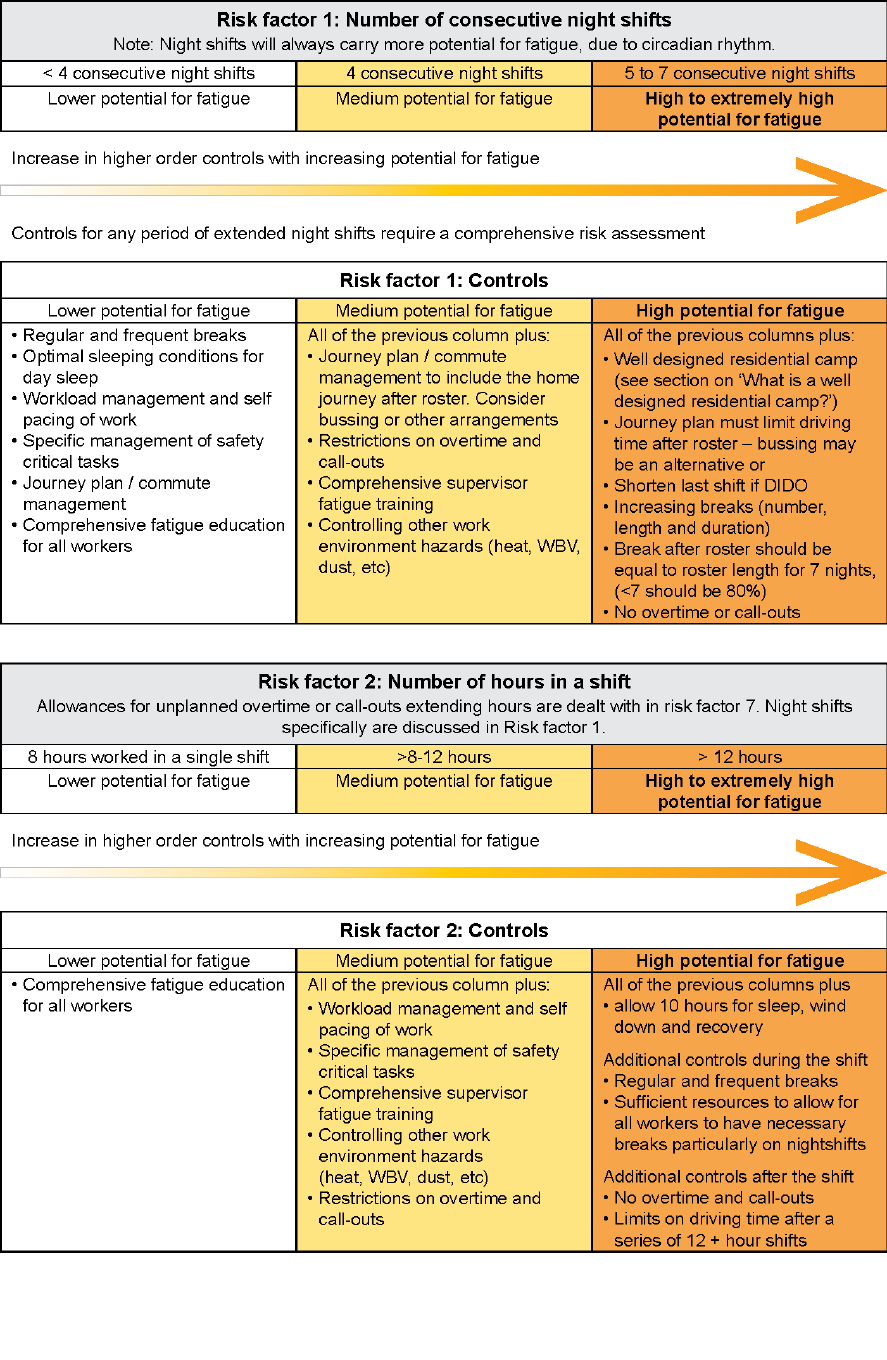
Table 1: Direct risk factors
36
Direct risk factors have a direct influence on fatigue (a number of factors are inter-related,
see information for each fatigue risk factor)
Direct influence on fatigue due to:
direct effect on sleep opportunity and quality
direct effect on extending wakefulness and increasing likelihood of onset of fatigue
effect of known individual and personal factors influencing sleep quality or opportunity.
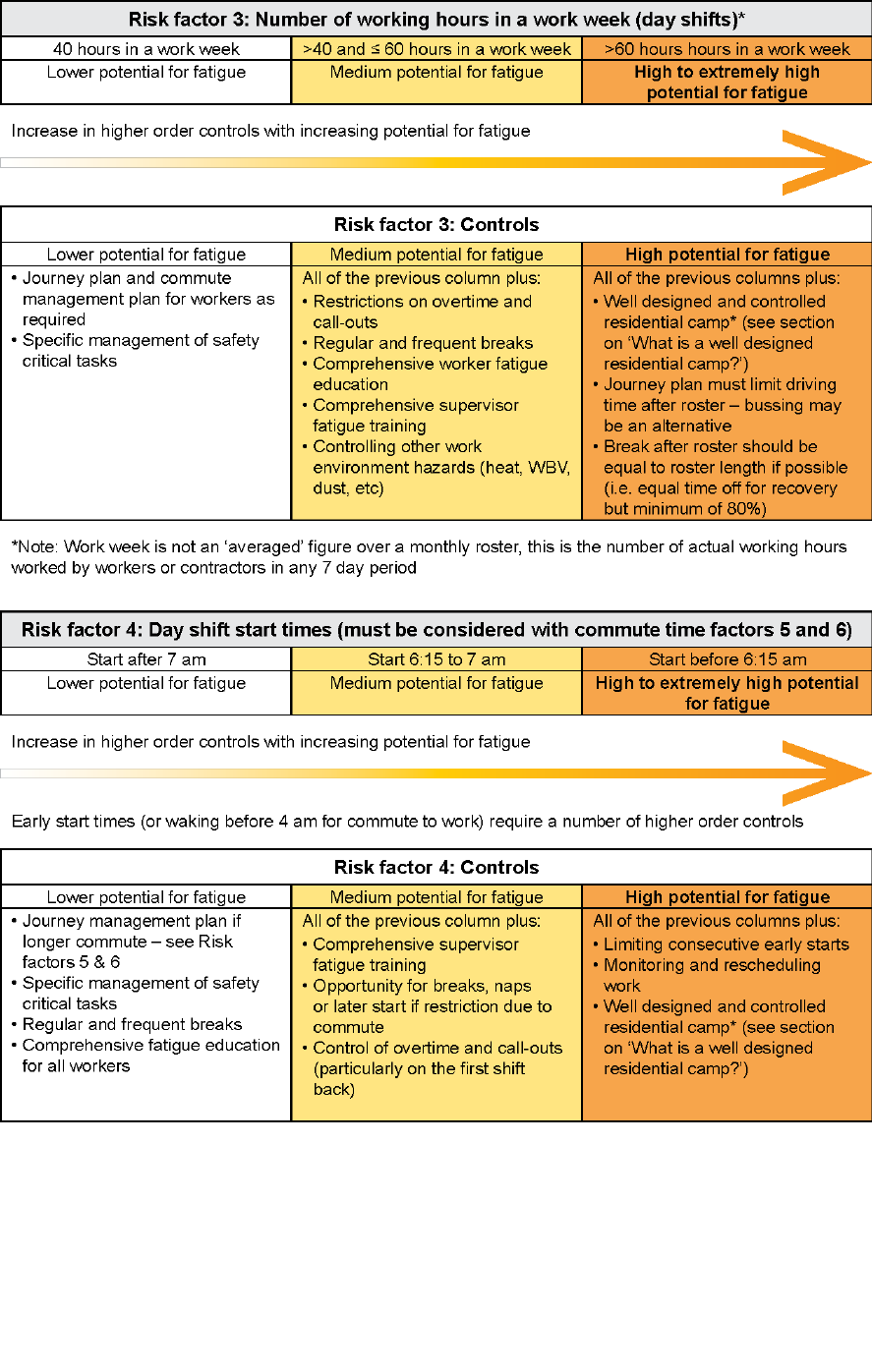
Table 1: Direct risk factors
37
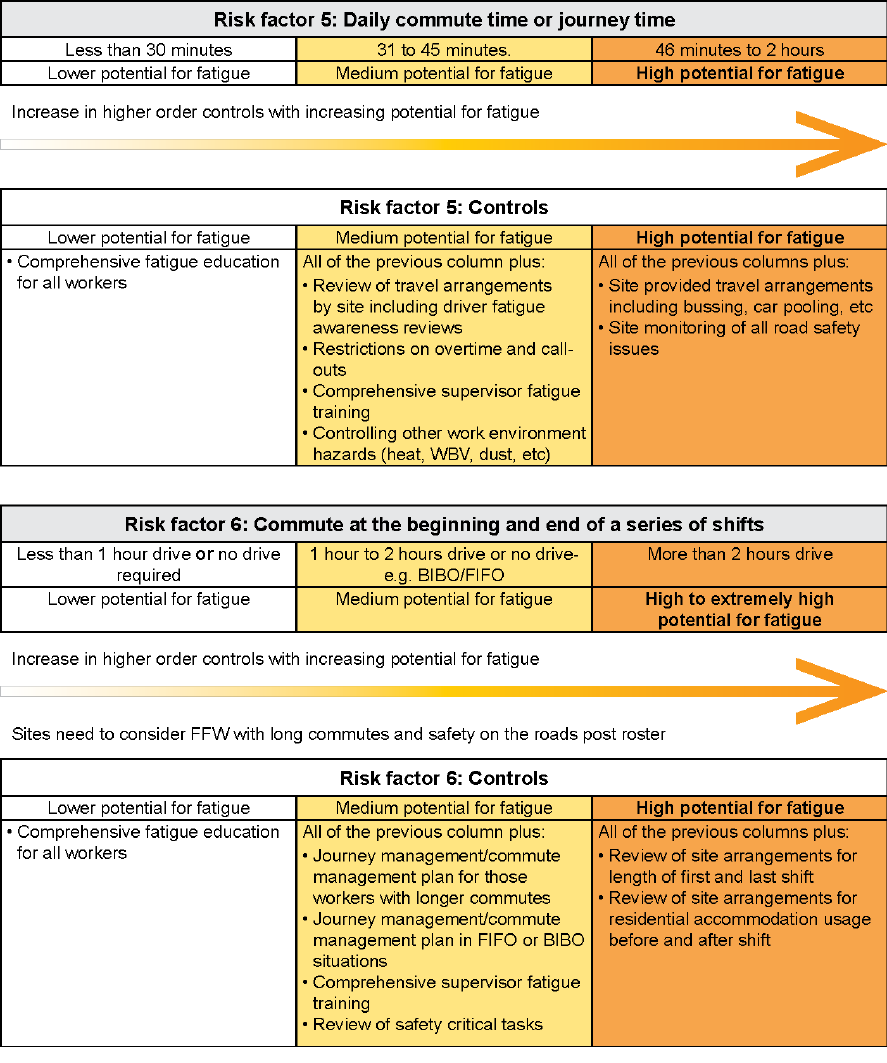
Table 1: Direct risk factors
38
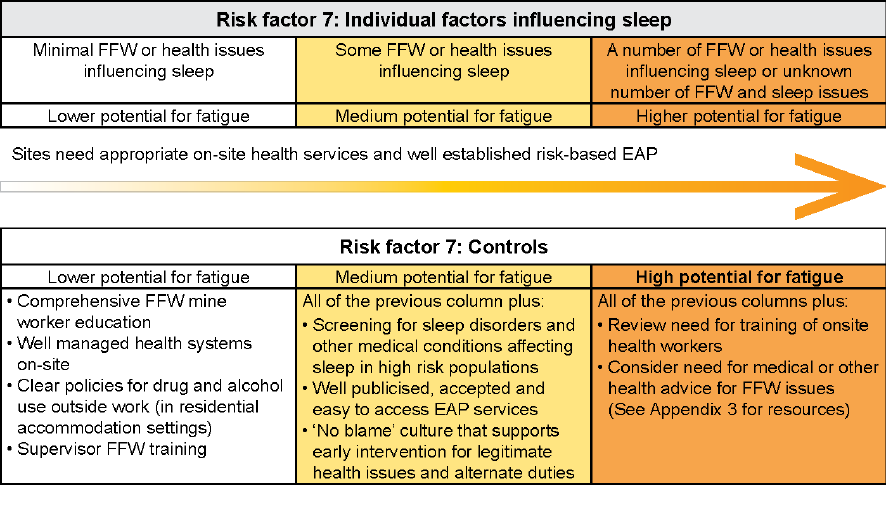
Table 1: Direct risk factors
39
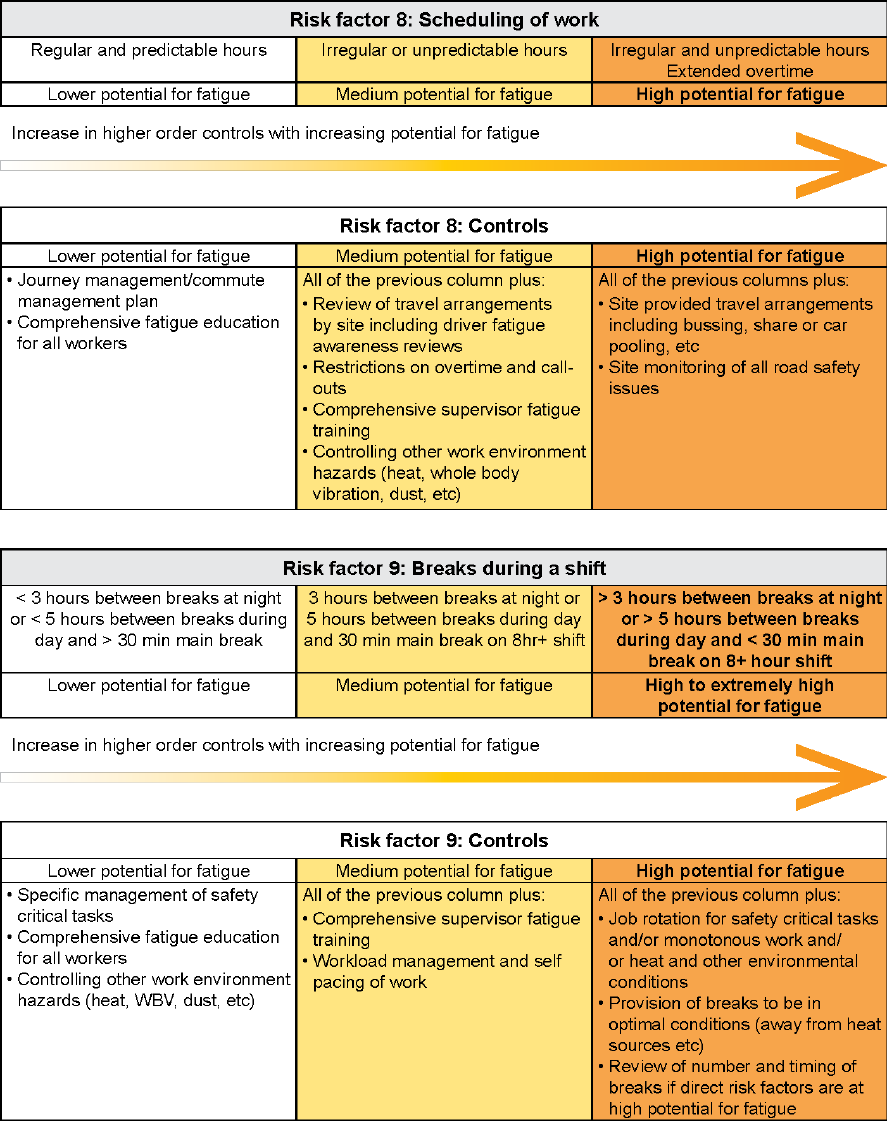
Table 2: Contributing risk factors
40
Contributing risk factors have a contributing affect on fatigue (a number of factors are inter-
related, see information for each fatigue risk factor)
Contributing affect due to:
affect on sleep opportunity and quality
affect on extending wakefulness and increasing likelihood of onset of fatigue
affect of known individual and personal factors influencing sleep quality or opportunity.
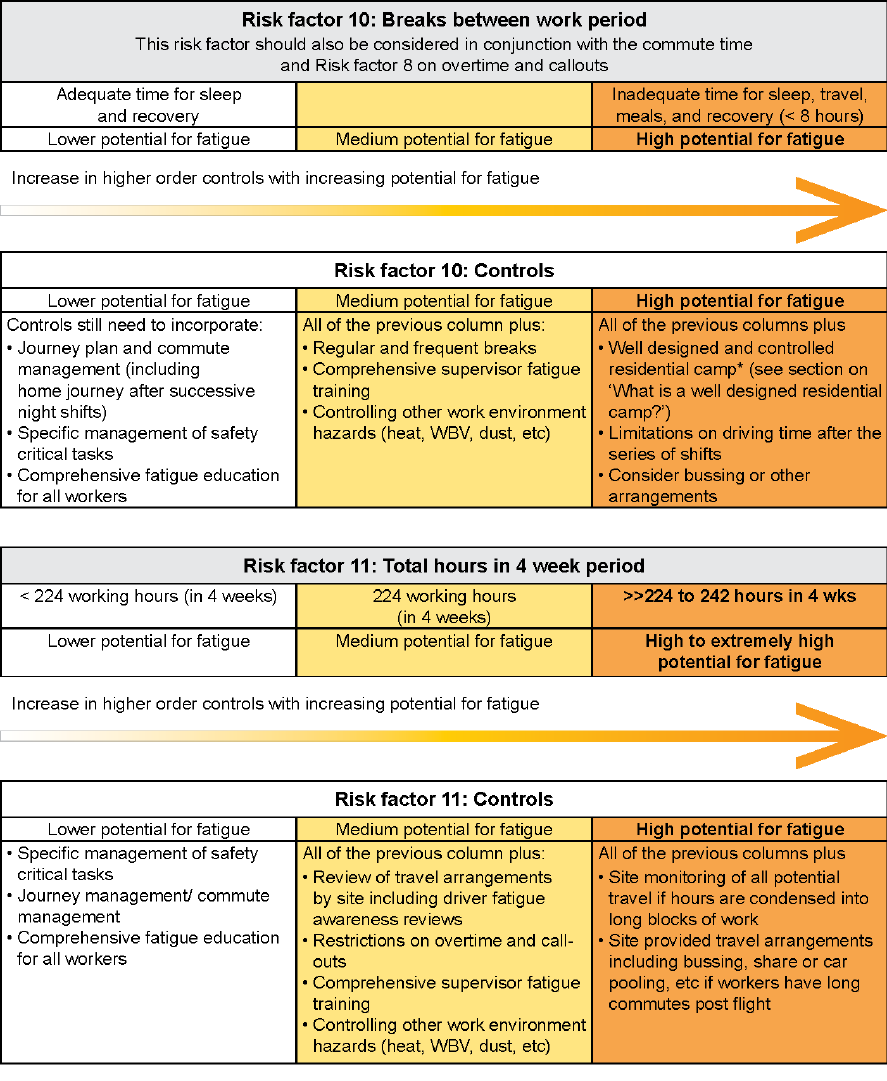
Table 2: Contributing risk factors
41
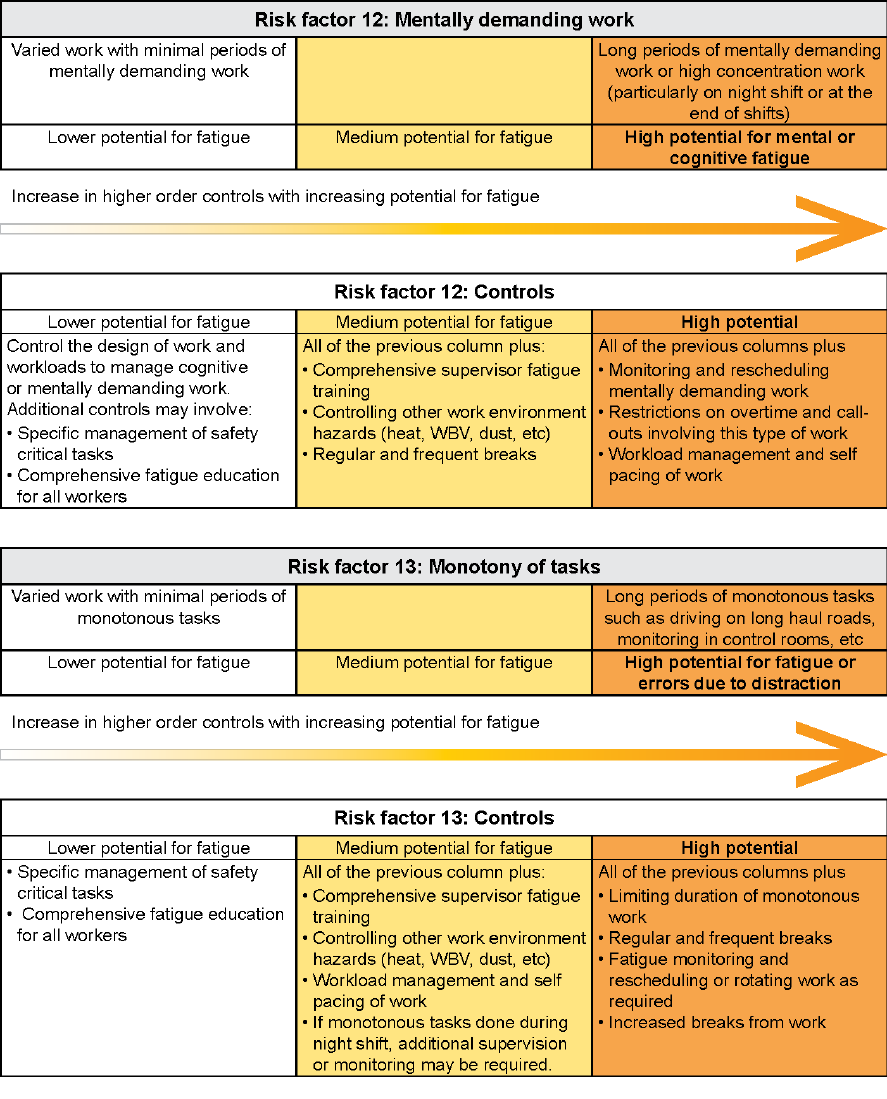
Table 3: Contributing risk factors - work design and
task specific factors contributing to cumulative
fatigue and potential health issues
42
Risk factors in this section will contribute to likelihood of fatigue onset or cumulative fatigue
and health effects.
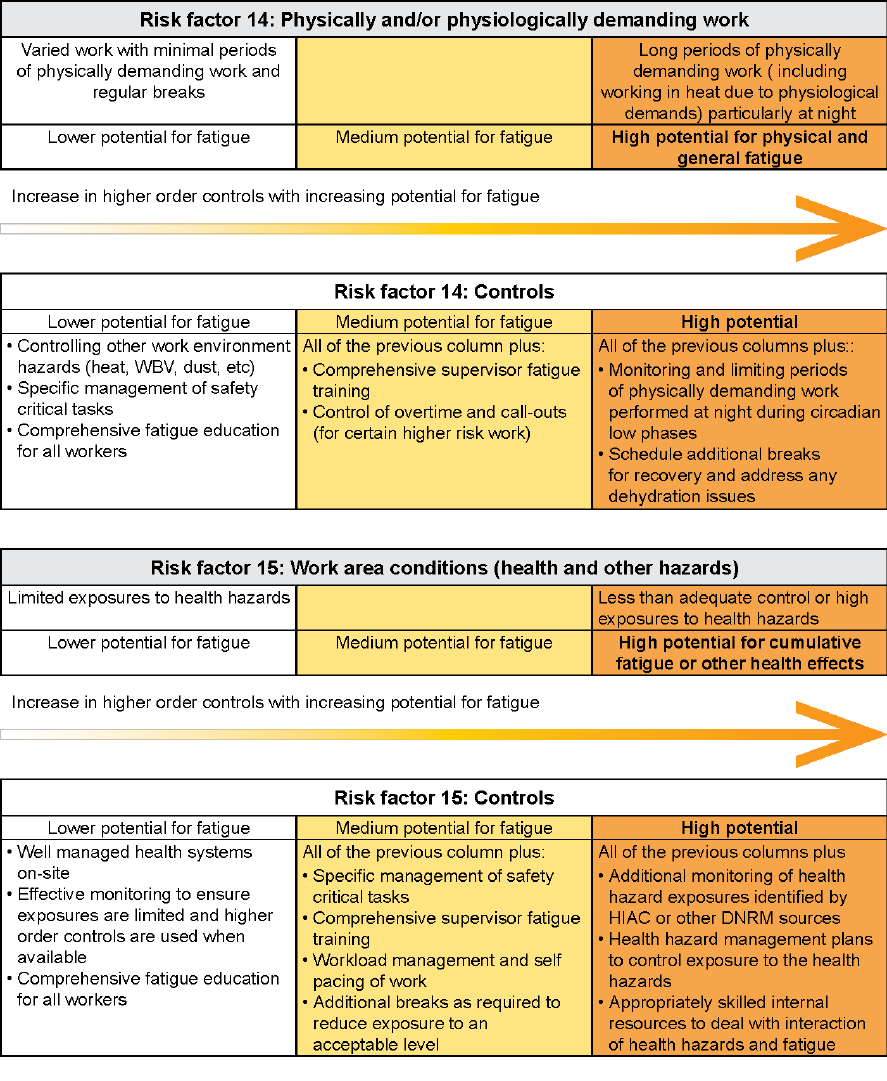
Table 3: Contributing risk factors - work design and
task specific factors contributing to cumulative
fatigue and potential health issues
43
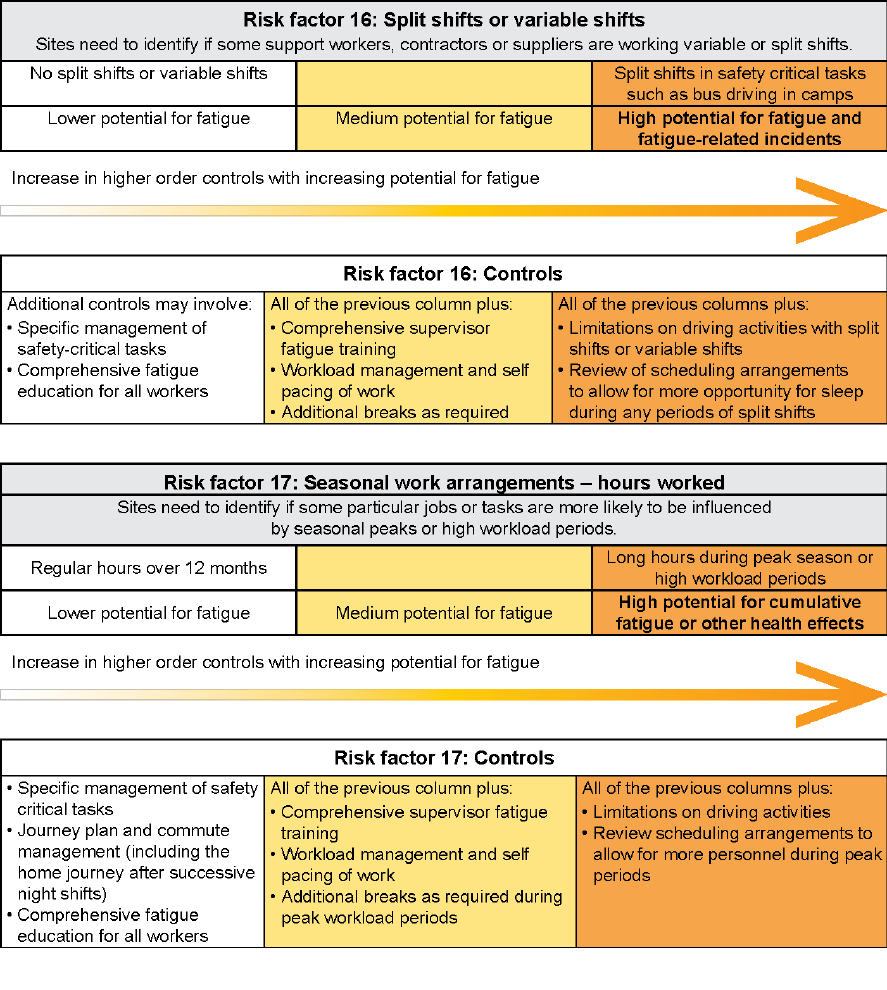
Table 4: Contributing risk factors - individual or site
specific factors contributing to cumulative fatigue
(some factors are inter-related, see information for
risk factors)
44
45
Some risk
controls may
need to be
trialled before
introduced
Some control measures may need to be trialled for their effectiveness
before they are permanently introduced. For example, if a roster is re-
designed, it could be piloted with a work group before it is finalised. The
testing will often identify any unexpected problems and give the
workforce a chance to trial the new arrangements without the normal
day-to-day work pressures.
5.5 Evaluation
Risk controls
must be
regularly
evaluated
As part of the risk management process, the control of risk factors
should be evaluated on a regular basis. The evaluation forms part of the
overall monitoring and evaluation of the fatigue risk management plan,
as described in Section 8.
46
6. Fatigue risk management plan documentation
The plan should
be integrated
into the Safety
and Health
management
system
A fatigue risk management plan should be integrated as part of an
overall health and safety management system. It should be:
specific to the site and type of work being performed by the
individuals covered by the plan
developed in consultation as required by legislation
available to workers and visitors and be clearly on display
communicated regularly to staff (e.g. through inductions)
reviewed to take account of changes in site needs and knowledge
about the risks.
The plan should
be fully
documented
The fatigue risk management plan should be fully documented and
include:
a statement of the principles for managing fatigue
roles and responsibilities and accountabilities for all levels of the
organisation
the risk assessments that have been undertaken
the risk controls that are and will be in place, along with an
implementation strategy
the support systems that already exist and that will be set up along
with an implementation strategy (such as hours-of-work monitoring,
employee assistance programs, training programs, monitoring
systems)
monitoring and reviewing the plan.
The plan should be written clearly and concisely and make use of
diagrams where appropriate.
The plan should
be audited and
assessed
The plan must be able to be audited and assessed by appropriate
authorities and be structured in a way that allows it to be evaluated and
monitored by internal and external bodies.
47
7. Fatigue risk management plan implementation
7.1 Introduction
Risk controls
must be put in
place
The fatigue risk management plan must be implemented. Without
adequate risk controls being put in place, the work that has gone into
preparing the fatigue risk management plan will not be useful. Key
issues to consider when implementing the plan include timeframes,
training, roles and responsibilities, accountabilities, communication and
participation, and assessment of understanding of the plan.
7.2 Timeframes
Actions should be monitored regularly to make sure that the agreed
timeframes are being met. Progress on the plan’s implementation is
necessary.
7.3 Training
Training gives
people the
knowledge and
skills to
implement risk
controls
Many of the risk control measures will involve workforce training to
promote understanding. Training is essential to good risk control by
giving the workforce the skills and knowledge they need to work with the
identification of and risk controls for fatigue. It also provides appropriate
information about the fatigue hazards and risks on-site. All site
personnel, including contractors, must be informed about the fatigue risk
management plan and have the skills and knowledge they need to fulfil
their roles and responsibilities. Coal mine sites have obligations for an
education program under the CMSH Regulation, s.42 (2).
In addition, operators/employers must provide education and awareness
about the site’s fatigue policy and procedures whenever:
new workers are appointed
induction or refresher training is provided
contractors or other on-site service providers are engaged (as part of
the contractor management plan)
changes are made to the fatigue risk management plan which
necessitates re-training.
The education and awareness training should cover:
the nature of fatigue
the warning signals of fatigue
the possible effects of fatigue
the factors that decrease or exacerbate the likelihood or effects of
fatigue, and
the control measures, including the fatigue risk management plan or
standard operating procedures (as required by the CMSH
Regulation).
Further training components incorporated in a number of programs can
be found in Appendix 1. Training must be arranged so it is available to
all workers on all shifts.
48
7.4 Communication
The workforce
including
contractors
must know
about the
fatigue risk
management
plan
The entire workforce, including contractors, need to know about the
fatigue risk management plan. When communicating the requirements
of the plan, the different needs of various groups on the mine site should
be taken into account. Some workers may have limited reading and
writing skills, whereas others may come from non-English speaking
backgrounds. Different communication methods should be employed to
accommodate the different groups and maximise understanding across
the entire workforce.
Once the plan is implemented, each worker has an obligation to monitor
their own fatigue levels and communicate any issues to their immediate
peers and supervisors.
7.5 Responsibilities
The whole
workforce to
participate in
implementing
the plan
All workers on-site, including contractors and other on-site service
providers, must be involved in implementing the fatigue risk
management plan and in making sure it is followed.
7.6 Supervision
Adequate
supervision is
required
Legislation requires proper supervision of workers (including
contractors) and appropriate supervision is an essential part of the
fatigue risk management plan.
Supervisors need to be able to identify when fatigue is a problem so that
they can initiate immediate control measures and report problems that
need to be addressed. This will usually require specific training, and
suggested training components are found in Appendix 1.
7.7 Reporting
Reporting
fatigue should
be encouraged,
not criticised
It is essential that workers (including contractors) are able to readily and
effectively report fatigue problems affecting themselves or others without
attracting criticism. This will require understanding and support from
supervisors and colleagues. Reporting is more likely in a working
environment where fatigue is recognised by all levels of the organisation
as being an important health and safety issue that should be properly
managed, and there are support systems in place to deal with non-work
causes.
It is also important that the site methods and tools for investigating
incidents where fatigue is a potential factor include the systematic
identification of fatigue as an underlying cause of errors or incidents,
including near misses.
49
8. Fatigue risk management plan: monitoring and
evaluation
The plan should
be regularly
audited and
reviewed to
make sure it is
still relevant
All aspects of the fatigue risk management plan should be audited and
reviewed to ensure the controls remain suitable, adequate, effective and
relevant. The hours worked by all workers, including professional staff
and management, should also be monitored and evaluated as part of
the fatigue risk management plan. Incident investigation tools should be
reviewed to ensure that they assist to identify the contribution that
fatigue may make to incidents.
Specific review
factors must be
considered
Specific factors to consider include:
Have control measures been implemented as planned?
Are they working?
Are there any new problems?
Do you have sufficient systems in place to identify fatigue in incident
or near miss investigations? If yes, the number of incidents, near
misses, injuries and other relevant data.
Appendix 1: Suggested components of worker (and
supervisor) fatigue risk management training
50
A number of organisations and providers offer fatigue awareness training for workers and
supervisors. The training can be delivered in a variety of ways, with some training (such as
training to comply with transport regulations) competency based and accredited.
Some typical components of most fatigue prevention and
management training include:
information on fatigue, what causes it and how it can affect people in a variety of ways
information on health effects of shiftwork, fatigue and health factors that influence sleep
common terminology including circadian rhythm, wakefulness, and other technical terms
used in the fatigue risk management plan at the site
practical information on how to get better sleep
how to report fatigue problems and use the recommended Employee Assistance
Program (EAP) or health services on-site
information on countermeasures such as caffeine, naps, lighting – as recommended on-
site
information on-site management of fatigue and mine (or coal mine) worker
responsibilities
considerations for a safe and healthy diet and eating habits while working shift work
managing fatigue and alertness levels
balancing work and home life.
Supervisors may require further skills to identify and manage fatigue in their crews, as well
as dealing with individual issues, and planning or changing rosters or work hours. For
example, if a supervisor is scheduling overtime or making decisions on who will be working
overtime (or scheduling call-outs) they will need to have further training in fatigue risks
involved with overtime and call-outs.
If supervision is a key component of site control measures for worker fatigue, the supervisor
is a key component of the fatigue risk management system and they require skills and
competency on how to:
identify the signs and symptoms of fatigue in crews and individuals
communicate policies, procedures and systems of fatigue risk management to workers
identify workers who require referrals to EAP or occupational health services for
conditions (or situations) that may influence their FFW due to fatigue
identify fatigue causal factors in their investigation of incidents or near misses
manage potentially fatiguing conditions such as overtime, scheduling changes, rostering,
etc according to site policies and risk management processes.

Appendix 2: Tips for individuals on avoiding fatigue
51
These tips are meant for workers who are at risk of fatigue due to work or non-work factors.
Sleep
The best sleep is night sleep.
If sleeping during the day, completely darken the room and allow more
time than normal to fall asleep.
Choose a quiet, peaceful place to sleep and adhere to a routine.
Seven to eight hours uninterrupted sleep is adequate.
Establish and maintain a routine around work, exercise, rest and sleep.
Seek medical advice for excessive snoring, irregular breathing and
insomnia.
Drugs and
alcohol
Avoid excessive consumption of alcohol – it affects quality of sleep.
Avoid stimulants – they delay the need for sleep.
Do not consume coffee or tea before going to bed.
Health and
medical
conditions
Schedule six-monthly medical checkups.
If you have a medical condition, seek advice from your doctor if you are
in a job that involves shift work or long working hours.
Tell your employer about any medical conditions that may limit your
ability to work or make you susceptible to fatigue.
Ask your doctor for an alternative medication if it causes you
drowsiness when you need to be awake.
Fitness
Maintain a basic level of fitness.
Exercise regularly but do not exercise immediately before going to bed.
Keep your weight in check – obesity contributes to sleeping disorders
and general discomfort.
Nutrition
Obtain dietary advice particularly for diet when on night shift (dieticians
who provide specific advice can be found at the Dietitians Association
of Australia) http://daa.asn.au/
Maintain a healthy diet and healthy diet routine.
Avoid large and or heavy meals before going to bed.
Mental health
A number of psychological conditions as well as personal issues can
disrupt sleep.
Some work problems can also influence fatigue and stress at work.
Seek help from site Employee Assistance Program services, a
supervisor or on-site occupational health nurses if you feel that you
have issues influencing sleep or fatigue.
Depression
Anxiety
Modified from WorkSafe Victoria 2008. Fatigue prevention in the workplace.
Other information sources for workers for managing shift work or general information
on sleep and fatigue include:
WorkCover NSW, How to manage shiftwork guide, at:
http://www.workcover.nsw.gov.au/__data/assets/pdf_file/0016/15163/how_to_manage_s
hiftwork_guide_0224.pdf
CCOHS (Canada) website http://www.ccohs.ca/oshanswers/psychosocial/fatigue.html
National Sleep Foundation (USA) website http://www.sleepfoundation.org/

Appendix 3: Accessing further resources and
references
52
Some enterprises or mine sites may not have the internal resources required to develop,
implement, maintain and review effective fatigue risk management. Instead, operators and
other executives, such as SSEs may need to identify qualified specialists in various areas to
assist with certain aspects of the plan and possibly the training. The sources listed below
provide some useful resources and publications.
Resources
Occupational Physicians:
Australasian Faculty of Occupational and Environmental Medicine:
http://www.racp.edu.au/page/racp-faculties/australasian-faculty-of-occupational-and-
environmental-medicine
Ergonomists:
Human Factors and Ergonomics Society of Australia: http://www.ergonomics.org.au/
Other sources
Construction, Forestry, Mining and Energy Union: http://www.cfmeu.com.au/
Australian Workers Union http://www.awu.net.au/
Minerals Industry Safety and Health Centre: http://www.mishc.uq.edu.au/

53
References and other guidance on fatigue
Research presentations or publications
Åkerstedt, T., Czeisler, C. A., Dinges, D. & Horne, J. A. 1994, Accidents and sleepiness: a
consensus statement from the International, Conference on Work Hours, Sleepiness and
Accidents, Stockholm, 8-10 September 1994, Journal of sleep research, vol. 3, no. 4, pp.
195, accessed at http://www3.interscience.wiley.com/cgi-bin/fulltext/121643099/PDFSTART
on 13 July 2010.
Belenky, G., Wesensten, N.J., Thorne, D.R., Thomas, M.L., Sing, H.C., Redmond, D.P.,
Russo, M.B., Balkin, T.J. 2003, Patterns of performance degradation and restoration during
sleep restriction and subsequent recovery: a sleep dose-response study. J Sleep Res, vol.
12 no 1
Baker, A. & Ferguson, S. 2004. Work design, fatigue and sleep: a resource document for the
minerals industry [report], Minerals Council of Australia
Baker, A., Fletcher, A. & Dawson, D. 1999, Policy guidelines for a risk management
approach for shiftwork.
Baulk, S.D., Fletcher, A., Kandelaars, K.J., Dawson, D., Roach, G.D. 2009, A field study of
sleep and fatigue in a regular rotating 12-h shift system. Applied Ergonomics, vol 40: pages
694–698
Carter, T. & Muller, R. 2008, Occupational fatigue in the mining industry: diagnosis,
interpretation, management, presentation to the Committee on Occupational Fatigue in
Queensland Mining of the Queensland Health Improvement and Awareness Committee.
Crummy, F., Cameron, P.A., Swann, P., Kossmann, T., Naughton, M.T., 2008. Prevalence of
sleepiness in surviving drivers of motor vehicle collisions. Int Med J, vol 38, no 10 pages 769-
775.
Dawson, D. & Reid, K. 1997, Fatigue, alcohol and performance impairment, Nature, vol. 388,
pp. 235.
Fatigue and Performance Modelling Workshop, June 13-14, 2002 (2004) Aviat Space
Environ Med vol 75 no 3 (Suppl)
Folkard, S. 2007, Assessing work schedules by means of injury rate, paper presented at the
Ageing and working hours: 18th International Symposium on Shiftwork and Working Time,
28-31 August 2007, Yeppoon, Qld.
Ingre, M., Kecklund, G., Akerstedt, T., Soderstrom, M., Kecklund, L, 2008, Sleep length as a
function of morning shift-start time in irregular shift schedules for train drivers: self-rated
health and individual differences. Chronobiol Int, vol 25, no 2, pgs 349-58.
Kecklund, G., Åkerstedt, T., Lowden A., 1997, Morning work: Effects of early rising on sleep
and alertness. Sleep, vol 20, no 3, pages 215– 223.
Larue, G. S., Rakotonirainy, A, & Pettitt, A. 2009, Driving performance on monotonous roads,
in Proceedings of the 19th Canadian Multidisciplinary Road Safety Conference, Saskatoon,
Saskatchewan, June 8-10, 2009, Canadian Association of Road Safety Professionals.
Rogers, N.L., Whitwell, B.G., 2009, Fatigue and commuting in mine shiftworkers. Sleep, vol
32 (Suppl):A148.
Williamson, A. 2002, Fatigue, in National Heavy Vehicle Safety Seminar: 22-23 October
2002: Radisson on Flagstaff Gardens Hotel, 380 William Street Melbourne, Melbourne:
National Road Transport Commission.

54
* The above papers are a small sample only of the extensive published work on sleep and
fatigue. Most of these papers are publically accessible. Many research papers on sleep
and fatigue are copyright and must be accessed via the journal directly.
Guidance
Baker, A. & Ferguson, S. 2004,.Work design, fatigue and sleep: a resource document for the
minerals industry [booklet], Minerals Council of Australia, Kingston, A.C.T.
NSW Mining Industry Health Working Party 2009, Health management plan: a guide to the
development and implementation of a health management plan in the NSW mining and
extractives industry, version 1.0, Industry and Investment NSW, accessed at
http://www.dpi.nsw.gov.au/__data/assets/pdf_file/0015/303063/Guide-to-the-development-
and-implementation-of-a-Health-Management-Plan.pdf on 13 July 2010.
Tiernan, G. & Van Zanten, D. 1998, Development of an extended shift exposure limit
adjustment factor for coal mine dusts. Joint Coal Board Health and Safety Trust, Singleton,
N.S.W., accessed at
http://www.hstrust.com.au/MessageForceWebsite/Sites/326/Files/SIMTARS_Tiernan_1998_
Development_of_an_Extended_Shift_Exposure_Limit_Adjustment_Factor_for_coal_mine_du
sts_20081.pdf on 13 July 2010.
Western Australia. Commission for Occupational Safety and Health. Mining Industry Advisory
Committee 2006, Code of practice: working hours 2006, Mining Industry Advisory
Committee, West Perth, W.A.
WorkSafe Victoria 2009. Fatigue in mines: a handbook for earth resources, WorkSafe
Victoria, Melbourne, Vic., accessed at
http://www.worksafe.vic.gov.au/wps/wcm/connect/4b8f6a004071f2a18be1dfe1fb554c40/fatig
ue_handbook.pdf?MOD=AJPERES on 13 July 2010.
WorkSafe Victoria 2008. Fatigue prevention in the workplace, WorkSafe Victoria, Melbourne,
Vic., accessed at
http://www.worksafe.vic.gov.au/wps/wcm/connect/d98656004071f370932edfe1fb554c40/vwa
_fatigue_handbook.pdf?MOD=AJPERES on 13 July 2010.
Appendix 4: Principles for risk management scoping
and review to assist with planning the fatigue risk
assessment *
55
Scoping checklist for a risk assessment
A good scope should include the following:
1. An objective based on the expected deliverable
2. A description of the system to be reviewed and clear identification of the boundaries
3. An inventory of the potential hazards
4. A statement of external threats
5. A listing of assumptions
6. Identification of consequences of interest
7. The risk assessment method – the means of identifying the unwanted events
8. The risk analysis method – the means of calculating and examining the level of risk
9. The facilitator for the risk assessment
10. The scribe for the risk assessment
11. The risk assessment team or work group (identifying reasons for inclusion)
12. The time required (and venue)
13. The means of providing risk assessment results and the desired deliverable.
Risk Assessment Review Checklist
A review of a risk assessment should consider the following issues
1. Is the reason for the review defined?
2. Are the objectives of the review stated?
3. Is there a description of the system being assessed?
4. Are the boundaries clearly and unambiguously defined?
5. Is the documentation provided sufficient to understand the scope and function of the
system?
6. Is there a summary of the strategic, corporate and risk management context?
7. Are the participants identified together with their organisational roles and experience
related to the matter under consideration?
8. Is the range of experience/expertise of the team appropriate?
9. Is the facilitator identified together with related experience?
10. Is the facilitator appropriate?
11. Is the method of identifying the risks clearly identified?
12. Is the reason for the choice of methodology explained?
13. Is the method of assessing likelihood and consequence of the risks identified?
14. Is the reason for the choice of methodology explained?
15. Is there a hazard inventory table?
16. Is there a listing of external threats?
17. Are all the direct assumptions identified?
18. How was the acceptability of the risks determined?
19. Is the determination of the acceptability of the risks justifiable?
20. Are all the risks prioritised by risk magnitude and consequence magnitude?
21. Was the hazard identification process comprehensive and systematic?
22. Has the approach to each part of the study been consistent?

56
23. Have all the existing controls and performance indicators been identified and their
function determined accurately?
24. Have all potential new controls been identified, adequately assessed and assigned
performance indicators if adopted?
25. Is there a recommended action list giving actions, responsibilities and timelines for
completion?
26. Is there a review process to ensure the assessment is consistent with others
completed at the same facility/business?
From: Joy, J. & Griffiths, D. 2007, National minerals industry safety and health risk
assessment guideline, version 6, Minerals Council of Australia,
http://www.mishc.uq.edu.au/Resources.aspx
* Fatigue risk factors and interaction of risk factors may not be fully addressed by current
risk assessment approaches. Some risk assessment tools, assumptions and
methodologies are less applicable to complex interactions of risk factors, hence the risk
factor tables in this document.
Appendix 5: Key points for journey management or
commute management plan
57
As a minimum consideration for all sites:
Workers should complete and document a journey management or commute management
plan if they:
permanently reside more than one hour from site
regularly work 12 hour shifts
or
may exceed 16 hours of wakefulness while in control of a vehicle, or
are identified as requiring a plan in QGN16 risk factor tables.
Monitor and review journey management or commute management
plans
Use QGN16 or other guidance to ensure that workers are aware of their responsibilities to
notify site contact if there are changes to the journey.
Workers have obligations under MQSH Act, s.36 as follows:
“If the worker or other person has information that other persons need to know to fulfil their
obligations or duties under this Act, or to protect themselves from the risk of injury or
illness—to give the information to the other persons.”
Similar obligations exist under CMSH Act, s.39.
